














Large Canadian fire encroaches into county from north
BY MARCY STAMPERWildfires are now burning on all sides of the Methow Valley, with a fire burning near Blue Lake in the North Cascades, and a large fire that started in British Columbia pushing into Okanogan County over the weekend. The actively burning fires trapped the valley under a thick shroud of smoke last week that was declared “hazardous” over the weekend. The Blue Lake Fire was detected a little before midnight on Monday, Aug. 14. It had grown to about 290 acres as of Tuesday (Aug. 22).
The North Cascades Highway was closed for a week from the Silver Star gate, 22 miles west of Winthrop, to Newhalem, about 51 miles in all, but was scheduled to reopen on Wednesday morning (Aug. 23) for through-traffic only, with a pilot car, according to the Washington State Department of Transportation. (See details in box.)
Numerous firefighting resources have responded to the Blue Lake Fire, including interagency hotshot crews, U.S. Forest Service Type 2 crews, fire engines, rappelers, smokejumpers, and helicopters with water buckets, the Okanogan-Wenatchee National Forest said on its Facebook page.
Fire managers plan to burn strategic areas to prevent the Blue Lake Fire from threatening high-value recreation resources and infrastructure. These firing operations are expected to increase the size of the fire.
Firefighters are also looking for natural features like avalanche
The fire is burning just south of the North Cascades Highway and near popular hiking and climbing trails, such as Blue Lake, Heather/Maple Pass, and the Pacific Crest Trail near Bridge Creek.
chutes that could act as a control feature, according to Inciweb, an interagency information-management system.
In addition to the North Cascades Highway, many trails are closed, including the Pacific Crest Trail (PCT) from the North Cascades National Park boundary north to the junction with the Snowy Lakes Trail, and Maple Pass and Twisp Pass. There is a 70-mile detour for PCT hikers from Stehekin to the West Fork Methow trail in Lost River.
Blue Lake Fire behavior has been active, but had moderated by Monday. There are areas of isolated torching and spotting. The Blue Lake Fire was 5% contained as of Tuesday. The cause of the fire is under investigation.
The Sourdough Fire near Diablo Lake had grown to almost 6,000 acres, with 12% containment as of Tuesday (Aug. 22).
Most of the fire growth has been in remote terrain in the inaccessible northern part of the
Home ownership is out of reach for most of the Methow Valley’s working class — local residents whose jobs are located in the valley — and rental housing is scarce and expensive.
The valley’s housing market is increasingly driven by a limited supply of homes and high demand from high-income earners, many of them part-time residents or people who live here but work remotely. Many local wage earners simply can’t compete.
“Said most simply, we have a local housing supply issue,” said Simon Windell, chief operating officer of the Methow Housing Trust.
“High demand from high earners compounds an already overall constrained supply of housing, leaving negligible supply of market housing for local folks,” Windell said.
To address the housing dilemma faced by local residents, the Methow Housing Trust is exploring a new model of home ownership, called local housing easements, aimed at creating and preserving housing for people who live and work in the valley. The idea is to establish permanent easements on properties that would require occupants of housing on those properties to be full-time residents of the Methow Valley.
“We’re very early in this process,” said Windell, who has been researching the idea for the Methow Housing Trust. “We are interested in this as a tool to conserve housing for locals and there are a lot of details still to be determined.”
The Housing Trust’s interest in

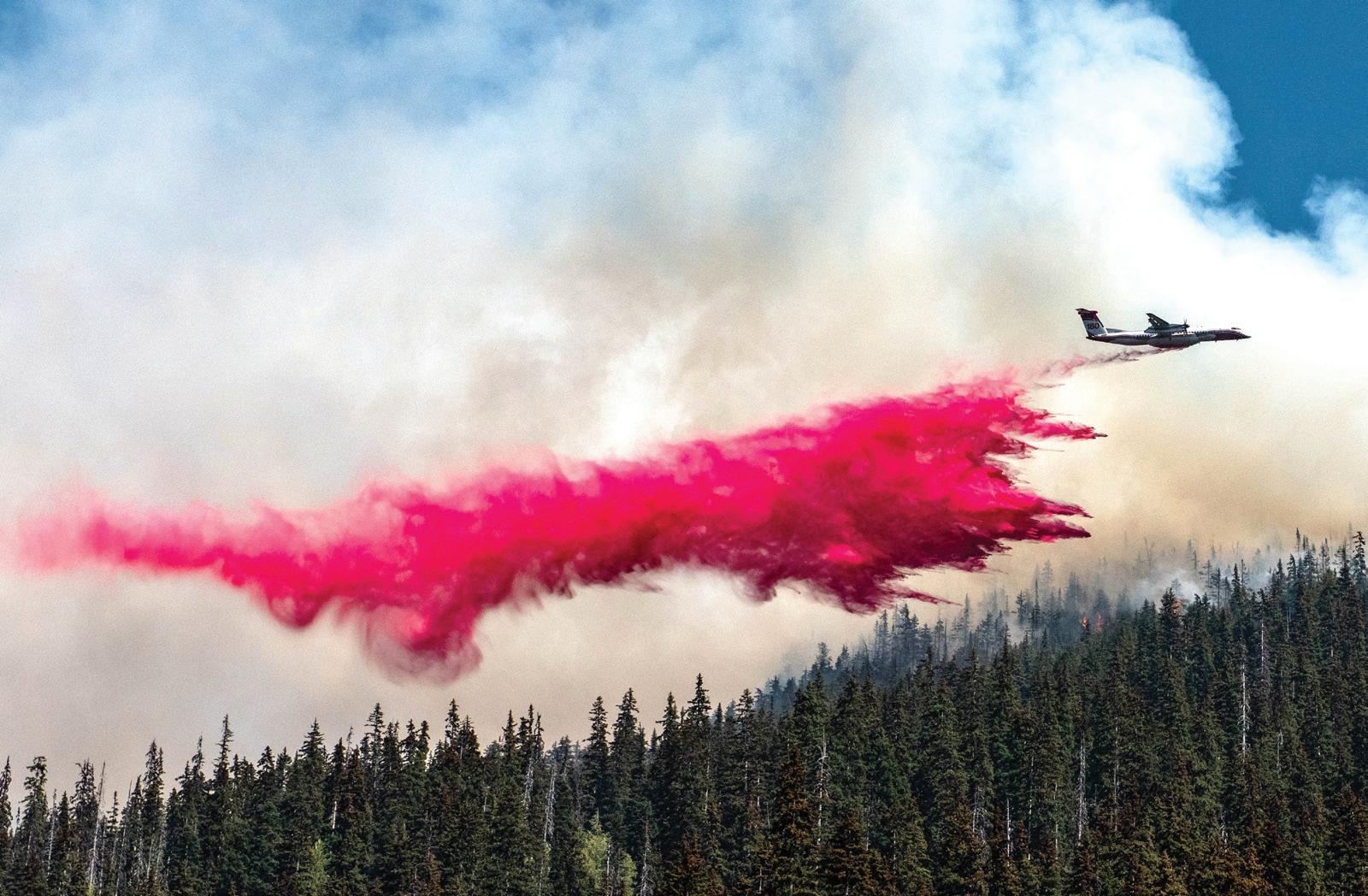
fire, where it is expected to keep spreading. The fire consumed a significant area in the north on Friday, when it sent up a huge
10 Operations Section
Hannah Fitchett’s experience with horses was limited to cleaning out stables — she’d never even ridden one — but she drew on her considerable resourcefulness and compassion and single-handedly rescued Hank, a buckskin quarter horse that had been missing in the Pasayten Wilderness for a week and a half.
Fitchett set out on a four-day backpacking trip Thursday, Aug. 3, planning to hike 53 miles from Billy Goat to Thirtymile. The night before, she had dinner with her parents in Winthrop, where she saw flyers about Dennis Gardner’s 16-year-old horse Hank, who’d been missing since he’d wandered off from a group of horses and mules out grazing on Monday night, July 24.
Gardner was at Spanish Camp with other guests and an outfitter, visiting lakes in the high country. Hank had

been there on previous rides and was familiar with the area so, after a couple of nights at camp, Gardner hobbled and put a bell on him and turned him out with the other horses and
In an era of increasing impacts from climate change, logging and thinning projects cause ecological harm to forests and won’t protect communities from destructive wildfires. Instead, we should focus on areas where people live by clearing vegetation and hardening homes.
Those were the central points at “Visions for a Fire Safe and Ecologically Sound Community,” a forum held in Twisp last week. The forum featured forest scientist and wildfire-management expert Dominick
DellaSalla; Methow Valley residents
Ric Bailey and Michael “Bird” Shaffer, who’ve been working on forest-health issues for decades; and environmental attorney Liam Sherlock. About 70 people attended.
The North Cascades Conservation Council (NCCC) helped organize the discussion because of its concerns about the impacts of U.S. Forest Service restoration, thinning, and logging projects in the Methow that encompass almost 200,000 acres, Bailey said for the NCCC. Wildfire is part of living in the Methow Valley, and to think you can control fire is not realistic, Bailey said. Naturally ignited wildfires replenish the soil, he said.
DellaSalla and the other panelists stressed that they’re not opposed to thinning or logging. But any restoration plan has to consider the entire
valley and conserve the ecosystem for future generations, Bailey said. DellaSalla maintains that areas that have been logged tend to have higher-severity fires.
It’s also crucial to remove slash piles once the work has been completed so that they don’t add more flammable fuel to the forest, Bailey said. In the Buttermilk area, after logging and thinning in the Mission Restoration Project, “there are clearcuts choked with flammable logging slash, which has been there for two summers,” Bailey said.
DellaSalla, who studies biodiversity and climate change, said the situation is growing dire, with the Earth on the cusp of warming by 1.5 degrees Celsius. While firefighters succeed in suppressing 98% of fires, the other 2%

The U.S. Forest Service has banned all campfires in the Okanogan-Wenatchee Forest — including in developed campgrounds and in the Pasayten Wilderness — because of continuing hot, dry weather and worsening fire-danger conditions. The ban went into effect on Friday (Aug. 18).
People can still use pressurized liquid-fuel stoves and lanterns, as long as there’s no flammable material within 3 feet. Wood-burning camp stoves are prohibited.
“This season we have seen a concerning increase in human-caused fires. Public cooperation is needed to help prevent new starts as hot and dry conditions continue across the forest,” Fire Management Officer Kyle Cannon said.
The Forest Service was also concerned by the potential for fires to spread rapidly over the weekend of Aug. 19-20. “Critical fire-weather conditions are forecast through the weekend and any new starts will have potential to get large quickly in these conditions,” Cannon said.
Stage 2 in the next week,” Okanogan-Wenatchee Public Affairs Officer Victoria Wilkins told the Methow Valley News on Aug. 8.
During the last week in July, weather was cooler than usual, with a high of 79 degrees in Winthrop on July 25 and 26, but the temperature hit 90 degrees by the end of the month. After several days above 90 degrees in early August, the valley had another respite until it was ambushed by the hottest weather of the season starting Aug. 14, with three days exceeding 100 degrees. The high of 103 degrees in Winthrop on Wednesday (Aug. 16) set a new record for that date, breaking the 2008 record by 1 degree, according to the National Weather Service (NWS).
Fuels in the Methow and Valley [lower Methow and eastern Okanogan County] Fire Danger Rating areas, which the state Department of Natural Resources (DNR) uses to monitor fire risk, were classified as “extreme” in DNR’s Weekly Wildfire Situation Update for the week of Aug. 21.
burn in such dry conditions and hot temperatures that they can’t be put out, he said.
Fires bring ecological benefits, whereas many aspects of fighting fire — such as soil damage from bulldozers and the use of chemical retardant — harm the environment, DellaSalla said.
Logging adds carbon to the atmosphere by removing large trees, which hold the most carbon, and by adding emissions from heavy equipment, DellaSalla said. Moreover, logging equipment, ground disturbance, and tree removal disrupt microrhizomes, a vital underground network that trees use to communicate, he said.
The U.S. Forest Service restoration projects aim to return the forest to historic conditions, but Bailey contends that the agency has selected a particular point in time, whereas forests have been evolving since the last Ice Age.
Millions of homes have been built within or near forests, directly in the path of wildfires, DellaSalla said. Rather than spending so much money in the backcountry, the emphasis should be on creating defensible space around homes and on hardening the structures themselves with nonflammable materials, he said. Ground fuels should be cleared within a 2-mile perimeter around private property, Bailey said.
TRP alternative
NCCC contends that forest projects proposed in the Methow Valley Ranger District have been fast-tracked, with insufficient opportunity for public involvement. The group says the projects aren’t based on the latest science and that they violate environmental laws and will have a detrimental impact on the Methow’s resource-based economy.
NCCC submitted an alternative plan for the Twisp Restoration Project, but says the Forest Service has refused to

consider it.
Co-presenter Michael “Bird”
Shaffer grew up on Poorman Creek. He studied environmental research and outdoor recreation and worked as a firefighter. “We can’t control wildfire, but we can work with it,” Shaffer said. We can create a plan that’s driven by ecology, not by economics, which can be a source for jobs in the woods, he said.
Several panelists raised concerns about the logging and thinning done in the Mission Restoration Project in the Buttermilk Creek watershed. The Mission Project used an approach that allowed loggers to select trees based on a description in the plan. But members of the public and an independent review by a forester contend that loggers cut more — and larger — trees than allowed. Paying loggers by the tree, rather than negotiating a flat rate for the project, provides an incentive for them to cut more trees, Bailey said.
Legal questions
Sherlock is lead attorney in NCCC’s lawsuit challenging the Forest Service’s planned logging of the Twisp River watershed.
Sherlock provided an overview of the National Environmental Policy Act (NEPA), which supports science-based decision-making and provides opportunities for public participation in plans by federal agencies such as the Forest Service.
The Okanogan Conservation District has cost-share programs to help people create defensible space and for home hardening. For more information, visit www. okanogancd.org or call (509) 422-0855.
NCCC contends that when the Forest Service reduced the size of the TRP by more than two-thirds after much of the area burned, the change was significant enough to require public input. The lawsuit also argues that the Forest Service must do an environmental-impact statement to look at the cumulative impact of all proposed forest-restoration projects in the area.
Public comment
Attendees asked for more specifics about the panel’s proposals, including clearing a 2-mile buffer around homes, which would be substantial, one said.
One audience member was concerned by the fact that many forests near the Methow have burned at such high severity that they’re not likely to regenerate. “That’s not normal or sustainable,” she said. It can take years for a forest to regenerate, particularly when soils are dry, DellaSalla said.
“We have to get to coexistence with fire,” DellaSalla said.
Okanogan County and the state of Washington banned all outdoor fires starting Aug. 4 because of the high risk of wildfire. At the time, the Forest Service, which manages land at higher elevations, kept Stage 1 restrictions in place. Stage 1 restrictions prohibit campfires and charcoal fires except in established campfire rings at designated campgrounds, but allow campfires in some Wilderness areas, including the Pasayten.
“With the milder weather we’ve had recently, there is currently no discussion of bumping up to
From Page A1 burn scar from the 2015 Goodell Fire near Newhalem as a control strategy. As of Friday (Aug. 18), they had burned out areas toward the west and brought the fire to that scar, which they believe will be a good spot to hold the fire, Lange said. Still, there’s plenty of fuel left to burn, so crews are carefully managing the fire in that area, he said.
crews have been monitoring activity on the southwestern flank of the fire near the highway and Newhalem, with no significant flare-ups. Drones picked up heat near Newhalem, and a small fire east of there was being watched. The fire has continued to propel boulders and burning trees onto the highway, making it hazardous for firefighters, but fire crews have kept the fire from spotting south of the road.
In the north, where the fire is burning at an elevation of about 4,000 feet, fire managers are using helicopter bucket drops, as weather and smoke permit, to keep the fire from spreading to higher elevations. The fire is in patrol status near Diablo Lake and the community of Diablo. The Seattle City Light powerline from Newhalem along the highway has been reenergized, Lange said. The Sourdough Fire was started by lightning on July 29.
The Crater Creek Fire, which has burned 109,000 acres in Canada, surged across the border into Okanogan County on Saturday (Aug. 19). As of Tuesday, it had burned almost 5,000 acres in northern Okanogan County, in the Pasayten Wilderness and the Loomis Natural Resources
Campfires are now prohibited on all state and private lands managed or protected by DNR across the state. Pearrygin Lake and Alta Lake state parks also banned all charcoal and wood fires in early August.
Recreational target shooting is now banned throughout the Okanogan-Wenatchee National Forest.
The industrial fire-precaution level increased last week to partial hoot-owl, prohibiting the use of chainsaws and logging equipment except between the hours of 8 a.m. and 1 p.m.
The weather forecast was for cooler-than-normal temperatures and possible thunderstorms midweek, before a warming trend by the end of the week, according to DNR.
The Washington State Department of Transportation (WSDOT) planned to reopen the North Cascades Highway on Wednesday morning (Aug. 23) for through-traffic only, as of press time. WSDOT will have a pilot car to escort traffic through the Rainy Pass and Blue Lake area, according to WSDOT North Central Region Communications Manager Lauren Loebsack. Motorists should be prepared for a potential wait on either end, she said.
The highway has been closed from Newhalem, west of the Cascade Crest, for two weeks because of the Sourdough Fire near Diablo. That section is also scheduled to reopen.
The situation will be monitored and could change at any time because firefighting activity is ongoing and there could be flareups from burnouts near the roadway, Loebsack said. WSDOT is working with the fire-management team to clear debris along the highway.
All areas and trails accessed from the affected sections of highway are still closed, and people cannot stop and park, she said.
Conservation Area (NRCA). The fire was burning on the eastern flank of the British Columbia Cascades when it exploded 10-fold in just one night last week, as two fires merged. Dozens of people had to be rescued from a remote lodge in Cathedral Provincial Park in British Columbia.
Much of the area where the Crater Creek Fire is burning is remote, and the fire is not currently threatening developed areas, according to the incident management team for the fire.
Because there is almost 5,000 feet of elevation difference in different regions of the fire, some areas are actively burning and some are more moderate, according to the fire managers.
The Washington Department of Natural Resources (DNR) has closed the northern portion of the Loomis NRCA and the Cold Springs and Chopaka Lake campgrounds, along with other areas near the border. Many trails in the Pasayten Wilderness, including the Cathedral Driveway and Boundary Trail, are closed.
The Crater Creek Fire was ignited by lightning on July 22, 11 miles southwest of Keremeos, just north of the border. South of the Methow, the Airplane Lake Fire had burned almost 1,900 acres near Lake Wenatchee. The fire was started by lightning on July 7.
Smoke persists
After smoke hung over the valley for several days last week — with occasional clearing — air quality in the Methow Valley hit the “hazardous” category over the weekend. “Air Quality across the region is the worst in the U.S., and perhaps the world right now,” the National Weather Service (NWS) said on Sunday.
Some sensors that detect pollutants recorded over 500 on the scale that classifies anything above 300 as “hazardous.” On Sunday, the air-quality index hit about 450 on sensors from Mazama to Twisp.
Agencies that monitor air quality have extended alerts through Wednesday (Aug. 23) for all of eastern Washington, according to NWS.

addressing the local housing issue got a vote of confidence recently with the award of a “Game Changer” grant from the Community Foundation of North Central Washington. The grants are intended to help nonprofit organizations “improve the quality of life in the Methow Valley.”
With the $9,500 grant, the Methow Housing Trust has hired and begun working with a land use attorney to explore the idea of developing a local housing easement program.
“We are aware ... that housing is at the center of community health,” Windell said. “Methow Valley’s working class is increasingly having to choose between sub-standard housing ... living in cost-burdened poverty, or leaving.”
Widening chasm
The high demand for housing in the Methow Valley by high earners leaves a “negligible supply of housing for local folks,” Windell said.
“With our median home price at $640,000, requiring three times the Okanogan County median income to buy, it’s clear that our housing market is driven by high demand from outside the valley,” said Windell. And trends indicate the situation isn’t getting any better.
“Given this external demand and capacity, as new market-rate developments are proposed, it is not likely that this increase in supply will introduce any supply of local housing, since local wages can’t compete, and demand is high,” Windell said. “Even when we add units, external competition will suck those up and you’re not solving the problem.”
Recognizing the external pressures on the housing market isn’t meant to “villainize” any segment of the valley’s population, Windell said. “We can both embrace and love our part-time neighbors or remote workers and have a desire to conserve housing for locals. There is room for both, but right now we need to focus on conserving and creating housing for locals, as the market is not delivering.”
There are two programs in the Methow Valley that provide housing assistance to local residents who can’t compete in the open market, he said. The Housing Authority of Okanogan County provides rentals for people who earn 60% or less of the area median income ($40,000 for a household of two), and the Methow Housing Trust provides home ownership opportunities for people who earn up to 150% of area median income ($100,000 for a household of two).
Both organizations have made meaningful progress in providing affordable housing for the people who qualify for their programs, but “there is a widening chasm between these people served, and what’s available on the open market,” Windell said.
Based on 2020 census data, about 35% of the population of the Methow makes between 120%-300% of the area median income — with 300% area median income the approximate requirement to afford the median priced home, Windell said. “This means that up to


35% of the current population is unserved by any market, subsidized or otherwise, for home ownership opportunities,” Windell said.
People who fit into this demographic — for instance households of two teachers, or a biologist and a baker — may be discouraged from ever moving to the Methow Valley because they have no hope of owning a home here, Windell said. And that means that employers, even those offering career positions, have difficulty filling jobs and retaining employees, he said.
“Employers like the Forest Service have had a hard time filling positions earning $80,000 or more because people (job applicants) couldn’t afford a home here. I’ve got a couple of friends thinking of buying a house in Wenatchee because they can afford one there, but they would have to leave their jobs here,” Windell said.
Fertile ground
“It’s clear that our community needs a tool that towns and developers can utilize to ensure that, when housing supply is added, it has a positive effect on supply of housing for local folks, permanently,” Windell said.
That’s why the Housing Trust is exploring the concept of local housing easements. The idea is comparable to conservation easements managed by the Methow Conservancy that provide permanent protection for open space, farmlands and wildlife habitat, Windell said.
“We’re looking similarly at the housing stock in the valley. In order to preserve the character of the valley we need to make sure some portion of the housing stock is protected permanently,” he said.
Local housing easement programs are being used in a number of recreation-based communities with housing pressures similar to those of the Methow Valley, where local wage earners are priced out of the market. The Colorado ski towns of Vail, Crested Butte, Aspen and Breckenridge have all implemented versions of local housing easements to protect housing for local residents. “I’ve talked to the housing or development directors in each of those towns. Each one of them has somewhere around 1,000 units under what they call deed restrictions,” Windell said.
While deed restriction programs “are a matter of course for a number of recreation-based communities,” the approach has been discussed but not implemented in any Washington communities, Windell said. The Methow Valley would be the first in the state to try it.
“The beauty of the Methow is we are fertile ground,” he said. “We have an opportunity to show the art of the possible.”
In its most simple form, a local housing easement program would utilize deed restrictions as a legal tool to require that the owner of a dwelling be a fulltime resident of the Methow Valley. In effect, it “changes a portion of the housing market from a national market to a local market,” Windell said.
Windell said adopting a local




housing easement approach would put in place a program of management to protect housing for local residents. The program is built around a restriction on the deed to the property “such that it runs with the land,” binding subsequent as well as present owners, Windell said.
“It creates a program of management, very similar to the way the Housing Trust manages the community land trust homes,” he said. The Methow Housing Trust retains ownership of the underlying land on which it builds homes, and enforces the residency, income, and resale restrictions on its homes.
Under the local housing easement approach, ownership of land and structures would transfer to new owners when the property is sold, but the underlying legal restrictions that require occupants to be local residents would stay with the property, ensuring permanent housing for the local population.
The program would mesh well with the work already being done by the Methow Housing Trust, Windell said. “It enables us to expand our reach and impact, without having to fundraise every dollar and swing every hammer.”
Easements would be completely voluntary, and could be placed on properties through different ways, Windell said. For instance, developers “with community intent” could voluntarily dedicate a portion of new construction for the program. In fact, the idea has already generated interest, he said.
“We have a handshake deal with one local developer who said he is going to put an easement on one or two units,” Windell said.
The towns of Winthrop and Twisp, which are both working on housing action plans, could create incentives for local housing easements by allowing higher densities or annexation of new developments that set aside some portion for easements.
In some communities with established local housing easement programs, local nonprofit organizations and/or municipalities have developed programs to pay property owners a percentage of the property’s market value to place an easement on the property.
And local lenders could also provide incentives for local housing easements in exchange for a lower interest rate on housing construction that includes easements, Windell said.
To get the program off the ground here, the Methow Housing Trust is “contemplating seeding the market with a couple of homes” that carry the easements, he said.
Windell said the Methow Housing Trust will continue working with the land use attorney it has hired to develop a proposal for a local housing easement program, including the legal framework, paperwork, and plans for enforcement.
“With this legal framework in hand, the Methow Housing Trust can determine what a program of management may look like, and we can go to the towns and developers and share more specifics … it’s exciting,” he said.
• On Aug. 10 at 9:12 a.m., a caller at a location on East Methow Valley Highway, Twisp, reported a bounced check.
• On Aug. 11 at 11:19 a.m., a caller on Libby Creek Road, Carlton, reported a dispute with their ex-spouse over whether their children could be taken out of the country on a vacation.
• On Aug. 12 at 8:40 a.m., a caller on Thurlow Road, Twisp, reported that a neighbor with mental health issues had come to the caller’s house and asked to see their radio because the neighbor thought it was causing them delusions.
• On Aug. 13 at 8:25 p.m., a caller on Wolf Creek Road, Winthrop, reported hearing gunshots across the valley.
• On Aug. 13 at 10:27 p.m. a caller at a location on North Methow Valley Highway, Twisp, reported a trespasser.
• On Aug. 14 at 12:44 p.m., a caller on North Lincoln Street, Twisp, reported that a couple had been “squatting” in a camper at the town park.
• On Aug. 14 at 10:12 p.m., a caller on Solitude Lane, Winthrop, saw people walking around with flashlights on a neighbor’s property and thought it might be a burglary, but then heard from the property’s owner that the persons were allowed to be there.
• On Aug. 15 at 1:28 p.m., a caller on Burton Street, Twisp, said they had asked another person to get a gold ring appraised, but instead that person had pawned it in Wenatchee.
• On Aug. 15 at 2:54 p.m., a caller on East Methow Valley Highway, Twisp, reported a poodle locked in a car and advised they might break the window, but then the vehicle’s owner approached and they began arguing, at which point the phone call ended, so we don’t know what happened to the dog.
• On Aug. 16 at 12:37 p.m., a caller on Highway 153, Pateros, reported that they were being harassed by a couple of relatives.
Winthrop Marshal’s Office
• On Aug. 10 at 11:44 a.m., a non-injury, two-vehicle collision was reported at Corral Street and Englar Street.
• On Aug. 13 at 8:52 p.m., a caller on Castle Avenue reported that a neighbor was doing outdoor burning, and they asked the neighbor to put it out, but the neighbor was unresponsive.
• On Aug. 13 at 11 p.m., a burglary was reported at a location on White Avenue.
• On Aug. 16 at 5:03 p.m., a deputy assisted someone who was locked out of their vehicle.
half-mile looking for something to graze on and return to camp around sunrise, knowing there’s grain awaiting them. But the next morning, Hank wasn’t with the others. Gardner remembers hearing a bell around midnight and believes Hank wandered off in search of feed during the middle of the night. Even with hobbles — buckled leather straps around their front legs connected by a chain — horses can get around fine, and even run, Gardner said. Gardner spent three days riding in the Pasayten looking for Hank. He’d follow the sound of a bell, but then it would stop. After Gardner returned to the valley, he even had a pilot fly him over the area to search for Hank, but they found no sign of him. Other hikers who saw the flyers also searched for him, Gardner said.
On the lookout
Fitchett, an archaeology intern for the Washington Department of Fish and Wildlife who lives outside Winthrop, was consumed with thoughts of Hank from the start of her trip. In her tent the first night, she heard a bell and went out to search, spending a fruitless halfhour trying to find him in the dark. She spent a fitful night, but said, “I would have felt guilty if I hadn’t looked.”
After a long day of strenuous hiking in the heat, Fitchett thought she might be hallucinating from dehydration when she heard a bell at around 4:30 on Friday afternoon.
But then she saw a horse near a pond, some 30 feet off the trail. She was able to text her mother, Rashel Fitchett, through an emergency communications device. Back in the valley, Rashel got in touch with Gardner.










Rashel relayed Gardner’s instructions to Hannah for removing the hobbles. “I was trying to become friendly with the horse,” but horses are so big that they can be intimidating, Hannah said.
She fed Hank grass and dried cranberries and he seemed to understand she wasn’t going to hurt him. Still, she was nervous as she stroked Hank’s face and neck and crouched down, trying to unbuckle the hobbles.
After she got the first hobble off, Hank was clearly relieved and became very cooperative. Following Gardner’s instructions, Hannah attached the hobbles to Hank’s leather bell collar and led him about 1 mile along the trail to a junction near Spanish Camp. “He was super-easy to lead,” Hannah said.
The junction had horse hitches and a forest cabin, but no one was there. Still, Hank was really excited — he clearly recognized the area. Hannah hiked another couple of miles down the Andrews Creek trail before she learned from her mother that Spanish Camp was in the other direction. But Hank knew the trail led home and absolutely refused to turn around, Hannah said.
With little daylight left, Hannah decided to set up camp and hike out the next day. Her mother told her a group of packers would be heading out in the morning, so Hannah fashioned a cord from her tent fly and tied Hank to a tree. She was jittery from the ordeal. “It was the longest night of my life,” she said.
When Gardner first heard from Rashel, he was doubtful it was Hank, since the horse had been missing for 11 days and he feared he was gone forever, Rashel told the Methow Valley News. But after some back-and-forth texts about the horse’s unique brown-andblack coloring, it appeared that Hannah had found Hank, Rashel said.


After Hannah explained, the woman leading the group put a halter on Hank and told Hannah, “You don’t know how many people you’ve made happy.”
Hannah followed them down the trail, where they met up with Gardner, who was heading up from the valley. She was exhausted and covered with charcoal from hiking through so many burned trees.
Gardner estimates Hank had wandered half a dozen miles from camp. He’d found plenty of food and water — he was in a marshy area with grass 2 feet high where Hannah found him, he said. Hank had some sores from the hobbles, but easily walked 16 miles out from the Pasayten. Hannah has done a lot of solo backpacking — last year she hiked the 500-mile Washington section of the Pacific Crest Trail — but rescuing a horse wasn’t part of her wilderness experience. In her archaeological work, she’s more accustomed to searching for cultural artifacts like arrowheads and old homesteads, she said.
Although the hike was hot and stressful, finding Hank was so rewarding that it was worth it, Hannah said. “It’s probably the coolest thing that ever happened to me while hiking. It feels like it didn’t even happen to me — it was like a movie,” she said.
Hannah told Gardner she’s not really a horse person. But she was inventive enough to figure out a way to lead Hank to the cabin without a proper rope or halter, and was brave enough to reach down to undo the hobbles — she was truly amazing and a godsend, Gardner said. “You did good,” he told her.
She was ecstatic when she heard hooves on the trail the next morning. Although the riders knew Hank was missing, they didn’t know Hannah had found him, so their initial elation turned to disappointment when they assumed it was another buckskin with his owner.




































Every fire season in recent years has had its own character, and this one is no exception. The good news, and the bad news, is that we’ve endured this before. The unhealthy pall of smoke, the highway closures, the heightened awareness of fire danger all around us — we’re not happy about any of it, nor are we panicky. Been here, seen that — and aren’t particularly pleased to see it again. But we have learned to anticipate, prepare, cope and adopt a responsible attitude as a community.
That doesn’t make it easy. As we went to press, the North Cascades Highway was reported to be re-opening this week, with reduced speed limits, but its closure slammed the tourism season at what is usually its height, and businesses are suffering. You can tell just by driving around and noticing the difference between say, last weekend, and a few weeks ago.
Many of us are inconvenienced by the extra driving distance to the west side when the highway is unavailable. It’s time-consuming and, with gas at $5 a gallon or more, costlier. Others have serious smoke-related health concerns that keep them indoors, or masked while outside. Some activities have been limited or canceled.
All that said, it’s also important to take a perspective check when we’re feeling put-upon by the fires’ consequences for us.
We’re not being burned out of our homes, like the people in Medical Lake, or Hawaii, or Yellow Knife, Canada. We have lost no lives to fire, for which we are thankful. While the “winter route” to the west side is longer and Highway 2 has its usual gauntlet of summer construction projects to run, we can still get there if necessary.
And by the way, people over there can still get here when the highway is closed — just like they do all winter, by the thousands, in worse driving conditions, all the way to Mazama. We’re not cut off from the world. A few years ago, when the highway was closed in the summer, local tourism marketing campaigns amped up that message to keep potential visitors informed that we were still open to accommodate them. Another way we can help ourselves is to make an extra effort to support local businesses and events.
While the Sourdough and Blue Lake fires have compromised a major transportation route and closed popular recreation areas that we also enjoy, let’s not forget to have a thought for the firefighters who are taking on those blazes every day. It’s dangerous, exhausting work whose satisfaction rewards are incremental. They are standing between us and much worse outcomes from the fires.
If the Washington State Department of Transportation, in concert with the fire management team, concludes that it’s too hazardous for motorists to use the highway with all the fire activity going on, let’s give them the benefit of the doubt instead of second-guessing. The first priority has to be safety, for the firefighters and the public. Nothing is so important that it’s worth risking lives over.
There is still time for things to rebound. Our tourism season extends well into fall these days, the smoke may clear and the highway may stay open. False cheer or gloominess are both unproductive, but optimism costs us nothing. We’ve seen in the past that there is usually a pent-up visitor demand when access to the Methow is limited, and people come back when and if they can. The best thing we can do is be ready for them.
An update on the Aug. 11 law enforcement raid on the offices of the Marion, Kansas, County Record, and the homes of the newspapers’ co-owners and a town council member, that we commented on in last week’s editorial: The county attorney issued a statement on Aug. 16 declaring that “insufficient evidence” existed to support the search warrant on which the raid was based, and directed law enforcement officials to return all equipment and materials that were seized.
That won’t be the end of it, of course. The Kansas Bureau of Investigation is looking into the incident, and lawsuits are likely. The best that can be said of the whole episode is that it drew national attention to an essentially lawless action, and renewed support for local media outlets that are doing their best to cover their communities even when they are feeling intimidated by people in power. We’d like to think the Marion County Record’s experience would make future depredations on press freedoms less likely. But we’re not that naïve.

Dear Editor:
The guest column in last week’s Methow Valley News, “Wildland firefighters need our support,” was particularly timely. Eight years ago this past weekend, three young, local firefighters died in the Twisp River fire. We should remember them: Tom Zbyszewski, of Carlton, Andrew Zajac, of Winthrop, and Rick Wheeler, of Wenatchee. All over the country, many more die each year.
More than just remembering them, we should be supporting efforts to give better pay to wildland firefighters. Until a year ago, their base pay was $15 an hour, less than minimum wage for a restaurant server in many places. Joe Biden got them a raise in base pay of 50%, still paltry but the best he could do by presidential order. Even worse, because that raise could only be temporary without congressional legislation, it will run out next month.
Please ask your federal representatives to support the Wildland Firefighter Paycheck Protection Act, now pending in the Senate. It’s not nearly enough to pay our debt to those women and men who risk their lives for us, but it’s a start.
Randy Brook TwispDear Editor:
In a letter in the Aug. 9 paper, Friends of the Pool members stated that an earlier letter “implies that we are asking the public to foot the bill of building the pool. Not so!” This contradicts FOP’s own study which states “[t] he pool will likely be funded through a range of public, private, and philanthropic funding sources, but it is likely that debt issued by the MPD [Metropolitan Park District] will be a prominent source of capital.”
The upcoming ballot measure would allow

tax revenues to be spent “to provide ongoing funding to develop, construct, operate, and maintain the Methow Aquatics Center and related existing and future facilities.” Those last six words are an undefined open door. They would allow this new, permanent taxing district to expand in unknown ways on the same site as the proposed $25-plus million pool complex, or elsewhere, at the discretion of future boards of commissioners without any further public votes. Voters should clearly understand this. All but one of the 23 MPDs in Washington are governed by elected boards. The governing board of commissioners of this proposed MPD will be appointed, not elected. Assurances by current pool advocates mean nothing. We are voting on the ballot language, not assurances printed in the newspaper.
A FOP-commissioned study estimated an outdoor replacement of the Wagner pool would cost less than half, or $10 million to $12 million less than the cost of the proposed indoor aquatic center, with an operational deficit of over $500,000 less per year. For comparison, $10 million to $12 million would pay for the new Winthrop fire station and the Twisp Civic Center with money left over. The difference in the operational deficits alone would pay for a new outdoor pool every 15 years or so.
Likely the permanent taxing demands of this proposed Metropolitan Park District will compete directly with many voters’ willing-
By Len Baublitzness to fund existing needs, i.e., the recent hospital special levy, EMS and school levies. I feel this is a fiscally irresponsible approach for replacing the Wagner Pool.
Shane Ruoss WinthropJennifer is a very experienced administrator, used to difficult budget decisions, shaping policy, and working to bring together people with different opinions. What we need today is someone who doesn’t bring an agenda to the table and who is willing to listen to all points of view. So I’m asking you all to take the trouble to vote in this offyear election, and vote for Jennifer Zbysze-
BY DON C. BRUNELLGrowing up in the 1960s, our parents blamed everything on “The Beatles.” According to them, they were “the punks” from Liverpool who caused all the teenagers to go crazy.
Lately, there is another group of “Beatles” giving people fits, only their names are spelled differently. These “beetles” are tiny insects that burrow under the bark of mature needle-bearing trees (conifers) and munch on the nutrient layers. In time, they suffocate whole forests and create immense debris fields.
In fact, those tiny bugs provide much of the dead wood fueling today’s conflagrations. According to University of British Columbia researchers, the mountain pine beetle damaged 45 million acres of pine forests across western Canada and the northwest United States in the last 40 years.
Jeffrey Hicke, a University of Idaho scientist, calculated by the time the enormity of beetle outbreak came to the forefront in 2012, the creepy-crawler outbreaks affected 30 million acres and killed 6 billion trees.
Throughout North America, forests are experiencing some of the worst wildfires in recent history. Correspondingly, insect and diseases epidemics starting 40 years ago were the worst ever. Beetle-killed trees only waited for the right conditions to ignite.
Beetles pack the forests by the billions. Hicke quipped: “I’d rather be a beetle than a tree.”
Soon after President George W. Bush took office, he proposed a healthy forest initiative. It was a way to clean up the woods and fight beetle infestations. Salvage logging would provide jobs and tax income for hard-hit rural communities where sawmills were shuttered by lack of timber from state and federal forests. That money would pay for tree thinning and seedling planting.
However, Bush’s plan succumbed to an avalanche of criticism from those opposed to logging and thinning calling it a “sweetheart” deal for the timber industry. It was an illogical argument which froze fire-fuel removal and heightened the dangers of wildfires. It spawned policies such as “let it burn.”
By 1988, bark beetles ravaged Yellowstone National Park and the National Park Service figured out its ill-fated “let it burn” policy backfired. The “Fires of ’88” charred 1.4 million acres in the Greater Yellowstone Ecosystem including a third of Yellowstone National Park.
At the peak of Yellowstone firefighting, 9,500 military and civilian firefighters were engaged, using dozens of helicopters, retardant bombers, and more than 100 fire trucks. Only the winter snow doused the flames. Suppression costs were the highest ever — $120 million.
Wildfire fuel
Fast-forward to 2023, by the end of June, wildfires raging across Canada released
more planet-warming carbon dioxide in the first six months of 2023 than in any full year on record. “The emissions from these wildfires are now the largest annual emissions for Canada in the 21 years of our dataset,” Copernicus Atmosphere Monitoring Service (CAMS) reported.
So far this season, 27.1 million acres have burned across Canada, and it is unlikely the fires will be fully extinguished until fall or winter when colder weather and precipitation arrives. The burned area is larger than the state of Kentucky.
“Much as is the case in the U.S., wildfires in parts of Canada have burned larger areas over time. A warming climate produces more extreme fire weather conditions in which hot temperatures, high winds and dry conditions overlap,” Axios.com reports. Add to that combination the trees killed by bark beetles providing massive amounts of wildfire fuel.
The good news is unlike the resistance Bush encountered 20 years ago, President Biden’s program to help communities to create fire breaks passed Congress with bipartisan support. In our state, Klickitat County received $5.5 million to create strategic fire breaks.
Unfortunately, the beetles were allowed to flourish, and the heavy damage is already done.
Don C. Brunell is a business analyst, writer, and columnist. He retired as president of the Association of Washington Business.

pm.; films at 3 p.m.
UPCOMING AT CONFLUENCE
“Mountainfilm on Tour: Mazama” returns for its ninth year over Labor Day weekend, offering three days of films at the Mazama Ranch House. Local organizer Paul Smotherman, co-owner of North Cascades Mountain Hostel in Winthrop, said that the eclectic program is “dedicated to educating, inspiring and motivating audiences about issues that matter, cultures worth exploring, environments worth preserving, adventures worth pursuing and conversations worth sustaining.”
Food will be available on Friday and Saturday, but not on Sunday.
The schedule:
• Friday, Sept. 1, “The Mountainfilm Medley,” a collection of short films that is a blend of adventure, social justice and the power of the human spirit. Doors open at 6 p.m.; films start at 8 p.m.
• Saturday, Sept. 2, “The Indomitable Spirit,” focused on individuals overcoming obstacles and making an impact in the world.
Doors open at 6 p.m.; films start at 8 p.m.
• Sunday, Sept. 3, kids’ matinee program in the Ranch House barn. Doors open at 2
This year’s format will be revised from past years. In the past, a “main event” has been scheduled for Saturday. This year, Smotherman said, “we want to emphasize that we’ve got three nights of films that matter. Something for everyone.”
• Sunday, Sept. 3, “The Big Green World,” films that tell the stories of innovators, visionaries and stewards of the natural world. Films start at 8 p.m.
A three-day pass is $60 for adults, $45 for those 18 and younger. Tickets for each of the three main shows are $20 for adults, $15 for those 18 and younger. Tickets for the matinee are $15 for adults, $10 for those 18 and younger. There will be no physical tickets; your name will be a call list at the entrance.
For information and tickets, visit mountainfilm.org/tour, then click on the Mazama event.









The Confluence: Art in Twisp will open two new exhibits in the main and community galleries with a reception on Saturday, Sept. 2, from 5-7 p.m. The exhibits, which continue through Oct. 7, are:
• In the main gallery, “Equus” — celebrating our fascination with horses — curated by Cheryl Wrangle and Caryl Campbell.
• In the community gallery, “Stop the World,” featuring works by Gregg Caudell. For information, visit www.confluencegallery.org.
POETRY READING AT TRAIL’S END
Poet Ruth Payne will be joined by other poets for readings from her collection of inspirational verse, “Gems from the Heart,” at Trail’s End Bookstore in Winthrop on Thursday, Sept. 7.
The free event, co-sponsored by Trail’s End and Methow Press, begins at 6:30 p.m. Light refreshments will be served, and books will be available for purchase. Contact Greg Wright at Methow Press for more information: (425) 381-1388.
ART WALK VENDORS
If you want to take part as a vendor in the Twisp Fall Art Walk on Saturday, Sept. 23, email info@confluencegallery. org for an application form. Applications are due by Sept. 9.
In September, The Merc Playhouse will host auditions for a Readers Theater production of “The Girl on the Train,” based on the Paula Hawkins thriller novel and film and directed by Jane Orme, and for the full production of “Clue,” based on the screenplay by Jonathan Lynn and directed by Kira Wood-Cramer.
• Auditions for “The Girl on the Train” are on Sept. 5 and 6 from 4-6 p.m. Roles includes three women ages 20-40; three men ages 20-40; and one of any age or gender. Performance dates are Oct. 13-22.
• Auditions for “Clue” will be Sept. 26 and 27, from 4-6 p.m. Roles include six men ages 16-60; and five or six women ages 16-60. Performance dates are Dec. 8-17.
Auditioners will be given pages to read. No previous experience or prepared readings are necessary.
The Merc’s full production of “Ripcord,” written by David Lindsay-Abaire and directed by Phil Quevillon, will have performances between Sept. 22 and Oct. 1. For information, visit www.mercplayhouse.org.
The information below was provided by Methow Music Monthly and other sources. For more information, visit www. methowmusicmonthly.com.
• Sundays, classical guitarist Terry Hunt at Twisp River Tap House, 6 p.m. No cover.
• Wednesdays, dance instruction with Debbie Bair at Twisp River Tap House, 6-8:30 p.m. $10.
• Wednesdays, Methow Ukulele Group meets at Mazama Store, 5-7 p.m. More information at geraldebell@yahoo.com.
• Wednesdays, “Wunderkind Wednesdays,” talented youth perform at the Twisp River Tap House, curated by Ilo Curtis, 6 p.m. No cover.
• Fridays, open mic jam with Gregg Hardy at Twisp River Tap House, 6 p.m.-closing. No cover.
• First and third Fridays, Soleil Kelley, Loren Boley and Isaac Shaw and friends, at Meza restaurant, Winthrop, 6-8 p.m. No cover.
• Thursday, Aug. 24, Buz Brose at 1908 Barbecue and Bourbon, Twisp, 7:30 p.m. No cover.
• Thursday, Aug. 24, Emele Clothier and Guest at Jupiter, Winthrop, 6-8 p.m. No cover.
• Friday, Aug. 25, The Paperboys deliver a high-energy evening of songcraft and musical composition at Twisp River Tap House, 7:30 p.m. Advance tickets $18; $20 day of show.
• Friday, Aug. 25, Mac Potts at Sweetriver Bakery, Pateros, 7 p.m. No cover.
• Saturday, Aug. 26, Norman Baker & the Backroads at Twisp River Tap House, 6:30 p.m. No cover.
• Saturday, Aug. 26, Waterdog at Sweetriver Bakery, Pateros, 7 p.m. No cover.
• Sunday, Aug. 27, American folk band with dual banjoists The Lowest Pair at Sun Mountain Lodge; $25.
• Saturday, Sept. 2, Swallowtail (Emele Clothier and Matt Armbrust) at Methow Valley Ciderhouse, 6 p.m. No cover with meal.
• Saturday, Sept. 2, longtime local favorites and Rhythm & Blues Festival regulars Too Slim and the Taildraggers at Twisp River Tap House, 7 p.m.; $17 in advance, $20 at the door.
• Saturday, Sept. 2, Jeremy Abbott Band at Sweetriver Bakery, Pateros, 7 p.m. No cover.
• Friday, Sept. 8, Nick Allen at Sweetriver Bakery, Pateros, 7 p.m. No cover.
• Thursday, Sept. 14, Buz Brose at 1908 Barbecue and Bourbon, Twisp, 7 p.m. No cover.
• Friday, Sept. 22, far-alt-country jam band Goodtime Hustle at Twisp River Tap House, 6:30 p.m. No cover.
• Friday, Sept. 22, singer/songwriter/guitarist Ali McGuirk at Sun Mountain Lodge, 7 p.m. $20.
• Tuesday, Oct. 17, singer/songwriter and recording artist Jeffrey Foucault at Sun Mountain Lodge, 7 p.m. $25.

In a way, the demise of the Pac-12 athletic conference is like the loss of a good friend. And an old friend.
For all my years on this earth there has been a Pacific Athletic Conference in one of its iterations. Indeed, for 108 years there has been an association of prominent West Coast colleges and universities bound together by the common interest of intercollegiate competition.
It seemed to be a commitment, an unbreakable bond in an exclusive club, only to be joined through special invitation with unique qualifications rooted in academic excellence, regional significance and athletic standing.
The University of Washington, University of California at Berkley, University of Oregon and Oregon State University first came together to form the Pacific Coast Conference in 1915. Those four were joined in 1917 by The State College of Washington (now Washington State University). In 1918 Stanford University was added, followed by the University of Southern California in 1922. UCLA in 1928 completed what became the Pac-8.
The Pac-8 lasted for 50 years before its expansion in 1978 to include the University of Arizona and Arizona State University to form the Pac-10. The University of Utah and University of Colorado, Boulder, were added in 2011 to complete the modern day 12-member alliance.
Those annexations to the conference didn’t happen without significant vetting, discussion, and the unanimous consent of all the current members.
But, as time has passed, conference alliance and tradition have fallen victim to the addiction of money, which is to say it
is all about football. And now there are four. Like hangers-on still hopefully lingering when everyone else has left the party, only Oregon State, Washington State, Cal/Berkely and Stanford remain after defections that started with USC and UCLA defying geographical sense by decamping to the Big 10, and concluded with Washington and Oregon joining them as the West Coast component of what is now the Big 16 or 18 or 20, depending on the day. In between, the Arizonas, Utah and Colorado bolted. And with them went a lot of powerful, personal connections.
The bet I first met Todd at Everett Community College’s Paine Field branch, while enrolled in the Park Ranger Law Enforcement Academy. Todd had recently graduated from the University of Washington, but we decided to partner up for the Washington State Park Ranger class of 1982’s three-week training session anyway. It was probably proof that as seasonal park aides with Washington State Parks, we were just poor and hungry enough to do anything for a full-time job.
After graduating from the academy, he went back to his Hood Canal area park at Scenic Beach and I headed for eastern Washington’s Potholes for the summer. I never felt it was merely coincidence that we would reunite as working partners just two years later at Deception Pass in July 1984.
It was that fall that “The Bet” began. This year will be the 40th renewal of our annual Apple Cup wager. The first payoff was a sixpack of Rainier Ale. I was kind of cocky, my WSU Cougars having knocked the Huskies out of the Rose Bowl each of the previous two years. We both traveled, separately, across the state to Pullman with our respective fiancés to witness the first of my many losses to come.
We got married about six weeks apart. We have shared a number of experiences, “The Bet” lasting through children, the
ADULT SWIM CLINIC
Friends of the Pool will host a free adult swim clinic at the Wagner Pool in Twisp on Saturday (Aug. 26), from 11:30 a.m.-12:30 p.m., for adults who would like to gain more confidence and sharpen their swimming skills. The clinic will be instructed by volunteer master swimmers and Killer Whales swim coaches. Register online at www. foptwisp.org.
Cascade Curtain, blowouts and nail-biters, transfers, promotions, and our annual conversation:
Todd: “Are we on for this year?”
Me: “Why, are you waffling?”
Todd: “I’m not. I just wanna know. I’ll take a merlot. It’s close to purple.”
Me: “Not so fast, I’ll take a nice crimson (OK, a rose).”
“The Bet” was even once mentioned in a Seattle Times article during Apple Cup Week a number of years ago, along with other goofy bets like the loser dressing in the winning apparel, singing the winning fight song and other forms of public humiliation that only a good spirited, longstanding rivalry can provide.
It’s also been very much an even competition, more than a few times with big stuff on the line: Rose Bowl trips and conference championships, the mythical “Northwest Championship” (concocted by then-UW coach Rick Neuhiesel), 365 days of bragging rights and, since 1962, The Apple Cup.
Some years, like 2008, the game was characterized by a desperate need for a win. The loser would be the worst team in the PAC that year. It was an Apple Cup that had ESPN.com’s Ted Miller writing, “to call this game a train wreck would be a disservice to train wrecks.” For the record, WSU won this game to finish the year at 2-10, the Huskies at 0-12.
Web of connections
All of that may have come crashing down in one big Apple flambe when the Ducks and Huskies threw in their fortunes with fly-over land.
The “realignment” of conference affiliations began more than a decade ago with the Southeastern Conference (SEC) and Big Ten growing from reasonably sized, single-division conferences to large, split-division conferences, preying upon other conferences.
Long-time rivalries and connections were what held conferences together. As I thought about things related to the sud-
RODEO QUEEN TRYOUTS
Tryouts for the 2024 Methow Valley Rodeo queen will be on Labor Day — Monday, Sept. 4 — at noon at the rodeo grounds on Twin Lakes Road. For more information, contact Amanda Hammer at (509) 264-3337.
NAVY CYCLISTS COMING THROUGH
On Thursday, Aug. 24, 30 riders from the U.S. Naval Academy class of 1983 are

den breakup of the Pac-12, it struck me that I have a personal connection to all 12 schools in the conference. Those connections start in Pullman and radiate out, many of them right here in the Methow Valley.
It started with the Washington State College, where my parents met at some sort of function in 1954. For myself, my spouse and a whole lot of other relatives, WSU is our legacy school. Once a Coug, always a Coug.
There are as many possible solutions for the four remaining institutions, none of them appearing to provide the same luster. The effect on regional rivalries, however, is more than significant. It’s pretty much devastating.
For longtime sports enthusiast, golf course operator, and classy Husky fan Bart Northcott, it is utter disappointment. “It’s a real shame,” he said in a conversation at the Bear Creek clubhouse
coming through Winthrop on their way to their 40th reunion in Annapolis, Maryland. They plan to ride over 3,400 miles to see the country, enjoy the camaraderie of their classmates and raise money and awareness for veteran issues. According to a press release, the riders have raised more than $120,000 to date. The group will start the next leg of its ride from the Hotel Rio Vista on Friday, Aug. 25, at 11 a.m. and proceed east from there. For more information, visit www.navy-cycling.com.
recently. “All of that tradition is gone now. The Apple Cup game is meaningless. It’s sad to see what college football has become.” Peter Fitzmaurice echoed Northcott’s thoughts, maybe with a little more sarcastic tone. “Isn’t it quaint to have thought that longtime rivalries and league affiliations mattered?” he rhetorically inquired. “The Big Game is always special,” he continued, reflecting back on his first couple of years at Stanford in 1970 and ’71. Stanford won the old Pac 8 both years, playing in the ’71 and ’72 Rose Bowls. Even if the conference survives and evolves, the Apple Cup has been emptied of significance. No longer will a Rose Bowl berth hinge on the winner. It is unlikely that the UW will want to play WSU in late November, just before the Big 10 conference championship and a bowl game at the risk of injury. More likely the game will be relegated to a September Saturday as a tune-up to conference play, essentially an exhibition game.
Indelible memories
For this lifetime Cougar, the Apple Cup memories are both fond and frustrating. I remember 1981, sitting high up in the Husky Stadium horseshoe. It was a day where maybe, just maybe, things will fall our way
in the Apple Cup and the Cougs will get to the Rose Bowl for the first time since the 1930 season. In the third quarter, news came from Los Angeles that USC had beaten UCLA and the Rose Bowl would go to the Apple Cup winner. It wasn’t to be for the Cougs that day, but a new world of possibility heightened the intensity of the game just another notch. It would be another 16 years (1997) before that dream would come true. I watched from my Twin Lakes living room with my wife and two kids, and teared up when my brother called, and cried when speaking to my dad a moment later (the previous Cougar Rose Bowl was a year before he was born). Todd presented me with two bottles of wine to celebrate that auspicious win.
Almost parenthetically, just five years later, I sat with my dad on the 15-yard line at the 2003 Rose Bowl, watching our Cougs play Oklahoma in the “Grandaddy” of them all, a phrase coined by 1954 Cougar grad Keith Jackson. I was hoping for the chance to sit at the Rose Bowl someday, with my Cougar son, and watch our Cougars play there, one more time on New Year’s Day. It looks, now, like that possibility has evaporated, into the memories of what once was.









Wednesday, August 23, 2023
After more than a quarter-century of focusing on negotiating conservation easements, the Methow Conservancy is moving into the new realm of land ownership and stewardship. As part of that evolution, the Conservancy hopes to also have a role in facilitating affordable housing.
With the recent purchase of a 1,200acre portion of the former Sunny M Ranch property, the Conservancy took on management of a diverse landscape which includes land near the town of Winthrop that could be suitable for affordable housing development. That could happen in collaboration with an organization such as the Methow Housing Trust.
The two missions — preserving land and creating affordable housing — might be considered contradictory. But in June, the Land Trust Alliance, a national organization which supports and accredits land trusts like the Methow Conservancy, hosted a webinar that illuminated the increasing collaboration between land trusts and organizations looking to have a role in affordable housing.
The Conservancy has purchased property before, but not with the intent of long-term ownership.
The organization was interim owner of what is now the Meadowlark Natural Area in Winthrop, which it purchased from the Heckendorn family in 2018 with funds donated to the Conservancy by Tina and Eliot Scul, intending to eventually sell it to the Town of Winthrop. In 2021, the town received a Washington Recreation and Conservation Office (RCO) grant of $444,000 to purchase the 139-acre property.
In May 2022, the Conservancy gifted the 328-acre x̌ námx̌ nam/Hummingbird property (x̌w námx̌w nam is pronounced “hwhenam hwhenum”) — known for decades as the Wagner Ranch — to the Colville Confederated Tribes in honor of the Methow people. The Conservancy purchased the property the previous year after a $3.6 million fundraising campaign for that specific purpose.
It was a land return without precedent, and it may be the first land returned from private to tribal ownership without legal restriction in the history of white settlement in what is now the United States.
Then came the Conservancy’s biggest leap to date: In June of this year, the organization purchased 1,200 acres in the heart of the valley that were part of the historic Sunny M Ranch, thanks to a whirlwind fundraising campaign that reached its goal of $8.7 million in less than six months.
The Conservancy said the campaign to purchase the property was driven by the desire to hold the land “on behalf of the community (both human and wild) in support of the following values: wildlife habitat, farmland, trail access, and affordable housing.”
Held in 26 parcels of varying size, the Sunny M land includes the largest irrigated farm field in the Methow Valley, dryland fields, shrub-steppe terrain, forested uplands, and several wetlands — plus land near Winthrop that has been identified as a potential affordable housing site.
Together, the Sunny M purchase and the organization’s work with the Colville Confederated Tribes and the Methow people signal a new era of conservation work for the Conservancy and perhaps for land trusts across the American West.
“When you see yourself as a part of nature,” said Methow Conservancy Executive Director Sarah Brooks, “you take responsibility for your role in it.”
At the forefront
Megan Lawson, an economist with Bozeman-based research nonprofit Headwaters Economics, says that recreation management is a common inroad for land conservation agencies to broaden their scope, but the Methow Conservancy is at the forefront of land trusts considering human needs alongside those of wildlife and other ecosystems. The overlapping array of ecological, economic and social challenges that communities like the Methow face encourages the Conservancy to take a holistic view.
In a May 2023 Headwaters Economics report titled “The Amenity Trap,” Lawson, a co-author of the report, identified many of the challenges that face communities endowed with recreational, aesthetic and tourism resources — communities like the Methow. Even decades after the final nail in the coffin of the proposed Early Winters Ski Resort, and safely behind the Headwaters Protection Act that stopped a catastrophic copper mine, the threat of being “loved to death,” as the report puts it, is a familiar feeling in the Methow. Facing a shifting landscape of pressure, the Conservancy is changing to meet the need for broader land stewardship.
For land trusts, Lawson says, “there’s a growing recognition of the need to get more involved in the questions around planning and zoning and housing and infrastructure.” But, she noted, few organizations are actually doing it.
In Vermont, the union of affordable housing and land conservation predates the Methow Conservancy. The Vermont Housing and Conservation Board, founded in 1986, grew out of the beginning of an amenity trap. The board is funded by the Vermont real estate transfer tax and distributes grants to entities whose projects tackle both issues, or at least address one without impinging efforts toward the other. But, Lawson noted, the board most often funds projects that address one or the other.
Washington’s equivalent, the RCO, focuses on a different intersection. At one time, those two were thought to be opposed. Now, they are widely considered two prongs of the same mission: protecting ecosystems for the communities that inhabit them.
Now, a similar trend is emerging among land conservation groups: As land trusts increasingly recognize humans’ role in ecosystems and landscapes, many are beginning to seek out avenues of collaboration between organizations that have been historically siloed in their approaches.
Recently, the traditional land trust model in general has come under question from some quarters that cite a lack of equity in access to protected land, as well as conservation’s role in the gentrification of rural places in the West. The Brookings Institute, for example, cited conservation easements as a common tax shelter for wealthy ruralites. Adherence to the traditional land conservation model, from which the Methow Conservancy appears to be diverging, has raised the important issues of equity and access.
Balancing goals
The Methow Conservancy formed in 1996, a merger between “a little fledgling group called the Methow Valley Environmental Education Center, and a little fledgling Methow Valley land trust,” said Brooks.
Although “it was a totally different world in 1996,” the Methow was already facing development, water use and conservation concerns, said Brooks, who has worked for the organization for more than 20 years.
Over its 27-year history, the Conservancy has balanced the work of a land trust, facilitating conservation easements with private landowners, with an educational component reflected in the organization’s motto: “To inspire people to care for the land of the Methow Valley.”
When Katharine Bill started as an intern for the Methow Conservancy in 1999, the organization was focused on documenting and monitoring its small collection of conservation easements throughout the valley. Bill later served as the stewardship director, then as the Executive Director. “It was very grassroots,” she said. “The goal of the organization was to be the ‘hub of the wheel’ for conservation work in the Methow.”
The board and staff recognized that the organization did not have the ability to take on conservation work beyond education and land conservation, but building up to that was a priority.
“Thoughtful and incremental growth” was the name of the game, Bill said; staff and board members thought that at some point, affordable housing would be a part of the picture for the Conservancy, but “land return was not on our radar; I’m sure new ideas will come up in the next 20 years that have not been a consideration in the past.” The organization, Bill said, existed “to protect land and bring the community together.”
“Now it’s a different story, and [the Methow Conservancy] has the backing of the community.”
From the beginning, Bill said, the community land trust (CLT) model was a part of the long-term vision, but the organization lacked the capacity to do

the work of a CLT. But now, with trust and resources built over time, Bill sees it as a natural step.
“I think it’s a perfect role,” she said, for the Conservancy to protect land and include affordable housing on that land. “When protecting land, the question arises of where development should happen; how can we support towns in finding enough water for their developments?”
Encouraging clustered development aligns with the conservation of contiguous habitat, ecosystems, and agricultural land. Bill says this land management work is less visible, but has been a part of the Conservancy’s work for several decades.
Associate Director Ashley Lodato said that while it may look from the outside like the organization’s interest in affordable housing is coming out of the blue, a study on the matter commissioned by the Conservancy in 2007 indicates that “it’s been on our collective mind at least since then.”
As for the increase in the organization’s capacity, “those seeds were planted in community involvement,” Bill said, pointing to programs like Farms to Neighbors, First Tuesday gatherings, and outreach programs that brought people into the fold, convincing them to care about conservation and about the Methow.
In the early years, Brooks said “it made sense for us to be a thoughtful but quiet organization working with landowners to do conservation easement work and learn how to do that well.” She said that the first push to expand came in 2013, on the heels of the Imagine the Methow campaign, a $20 million fundraising and awareness campaign aimed at conserving key habitat and viewsheds in the valley.
The campaign, which reached its fundraising goal in 2010 during the 16-year tenure of former Executive Director Jason Paulsen, drew widespread support from community members. The Conservancy wrote in a 2010 press release “Someday, our children’s grandchildren will eat fresh food from a Methow Valley farm, stand in awe at a sunset over wide open hills, or play in the clean and clear confluence of the Methow and Chewuch Rivers, and they will say a quiet thank you to those before them who made the choices that keep the Methow Valley so special.”
Brooks said that “at that point, we were influenced by some work just emerging from other land trusts to do what is called community conservation, which is that idea that a land trust shouldn’t just be about acres and miles of riverfront or these quantitative measures of success, but really needs to look at a whole community.”
For “our children’s grandchildren” to live in the Methow at all, the organization recognized, something had to be done to broaden the scope of conservation. It would rely, Lodato said, on the Conservancy’s longtime approach:
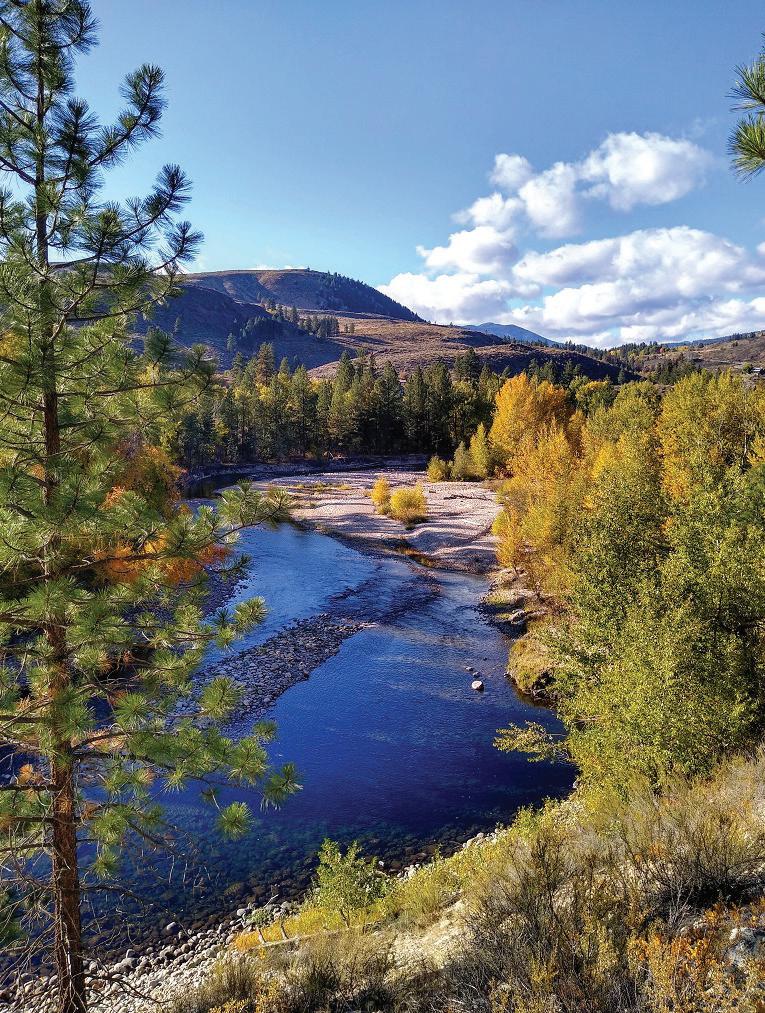
Though the capacity to support an expanded definition of land conservation is built on years of deliberate work by the Conservancy, the actual expansion, what Brooks calls the “nails-in-wood,” is a new horizon for the organization. Both the purchase of Sunny M and the return of the x̌wnámx̌wnam/Hummingbird property differ from the Conservancy’s methods over the last two and a half decades.
In 2018, the Methow Conservancy began working with the Methow Valley Interpretive Center, a Twisp-based nonprofit dedicated to “foster[ing] cultural awareness and understanding of Indigenous peoples and the natural history of the Methow Valley and Upper Columbia region through education, interpretation, creative expression and cross-cultural connections,” according to the Center’s website.
The return of the x̌w námx̌w nam/ Hummingbird land to the Colville Confederated Tribes on behalf of the Methow descendants was unprecedented, said David LaFever, the Interpretive Center’s executive director. “There’s no model to follow, and we’re willing to figure it out together,” he said.
Bruce Morrison, president of the Interpretive Center’s board of directors, noted the Conservancy’s willingness to work with tribal and nonprofit partners. “The Conservancy is wonderful at creating these visionary initiatives,” Morrison said in an interview. LaFever added that the Conservancy “partners with many different organizations depending on the specific project,” and “the Interpretive Center has been a key partner when it comes to working with the Methow People.”
“Tribal leaders across the region have taken note and inspiration from the Methow Conservancy’s willingness to put their considerable reputation and resources on the line not only to return land to honor Methow descendants, but to engage in ongoing collaboration with them,” Morrison added in a text message.
In June 2023, Methow Families, a group of Methow descendants and allies including representatives of the Conservancy and the Interpretive Center, received a $25,000 Game Changer grant from the Community Foundation of North Central Washington. The grant will support “cultural programming and land stewardship efforts” on the x̌wnámx̌wnam/Hummingbird property, according to the Conservancy, which assisted in the application process.
From its beginning as a land trust, the Conservancy has included educational programming and community outreach in its mission alongside the facilitation of conservation easements. Brooks says the organization has no plans to dial back the education or conservation easement work. Instead, the Conservancy plans to add land ownership and management, and its ongoing relationship with tribal groups, to its “toolbox,” she said.
The organization’s toolbox has grown in recent years, expanding the scope of the land trust’s work to include active land management, human housing considerations and relationships with regional tribal governments and the descendants of the Methow Valley’s original inhabitants.
“It’s not the Conservancy’s success or failure,” Brooks said. Instead, the outcomes of projects like Sunny M and x̌ námx̌ nam/Hummingbird will come “from the community wanting it to happen and trusting us and stepping up.”


HOUSEKEEPING POSITION NOW
District is
The Town of
to view full job descriptions and to submit an online application. Positions are open until filled
METHOW RECYCLES IS currently hiring for the position of Operations Coordinator. This position works in partnership with the recycling operations staff to ensure smooth day-to-day operations of the program and facility. This administrative role is responsible for scheduling, reporting, some bookkeeping, data entry, and community relations.
25-30hrs per week, Tuesday-Friday but may work some Saturdays. Compensation is $23-$26 per hour based on experience plus paid time off and health care or childcare stipend. Please send your resume or questions to sarahjo@methowrecycles.org, no phone calls please. Full job description available at methowrecycles.org
NEED GREAT PAY + Extra Cash? We are looking for a caretaker to look after our second home in Winthrop. Part time, you set your hours. Please respond with experience and resume to rsnyder@ soundford.com or call 206-7993837. If no answer leave a text with your name and number for a call back.
is recruiting a Systems Manager (SM)
The SM is responsible for maintenance of Community assets including Water and Sewer Systems, roads, common areas, campground, refuse building, pool, pool house and community properties in general and must be able to operate a tractor, plow and sanding truck. The position requires a Washington State Waterworks Operators Certificate that can be obtained on the job.
West Chewuch Rd, Winthrop. OCEC is an Equal Opportunity Employer.
CINNAMON TWISP BAKERY:
The Bakery is currently hiring for both Kitchen Support Staff and Front Counter positions. Join a fun team that enjoys a great work environment. Must be available midweek through the fall/winter. Wage range $15.74-$16/hr plus tips. DOE. Benefits include: free shift meal, employee discount, wholesale discounts, and paid vacation and bonuses after working one full year. Email resume to Cinnamon Twisp Bakery - info@cinnamontwispbakery.com or apply at 116 N Glover Street, Twisp MAKETING ADMINISTRATOR, WINTHROP Chamber of Commerce:
Are you a passionate marketing professional looking for an exciting opportunity? Join the Winthrop Chamber of Commerce as our Marketing Manager and be part of our next era of marketing success!
As the Marketing Manager, you’ll play a pivotal role in shaping our organization’s marketing strategies. We’re seeking someone with ample digital marketing skills and experience who can bring fresh ideas to the table. If you love social media and have a knack for creating engaging content, particularly videos, we want to hear from you!


The SM reports directly to the EMC Board of Directors and works at its direction. This is a part-time ( 80-100 hours/month) position with flexible hours. Candidate must be well organized, have strong communication and interpersonal skills, be self-motivated and independent, and be able to respond to emergencies. Compensation is approximately 40k annually, plus reimbursements for phone and mileage.

the opportunity for $80,000. Email Molly at howdy@ littledipperwinthrop.com.

31 EMPLOYMENT ADMINISTRATIVE ASSISTANT WANTED. Be part of a lasting legacy in our community by helping carry out the mission to ensure everyone has a safe place to learn to swim, stay fit, and enjoy the water. Friends of the Pool, a 501c3 non-profit seeks an organized, self-starter to help support the Board of Director’s work to support the Wagner Pool and build a new aquatics facility for the Methow Valley. The position carries out duties related to day-today business of a non-profit ranging from communications, event coordinating, to grant administration. The position is temporary to start with the potential to grow. For more information visit www.foptwisp. org and submit a letter of interest and resume to info@foptwisp.org. Part-time, flexible, work from home or office. Apply by Aug. 31. Position open until filled.
The successful candidate will start on a limited, hourly basis shadowing the retiring SM starting in Summer 2023 then transition to full responsibilities and salary March 1, 2024. Starting Wage: 30/hr, transitioning to full-salary by March 1st, 2024. Please send resume to: manager@ edelweissmethowvalley.org
LARIAT COFFEE ROASTERS in Winthrop is hiring. Looking to fill a permanent year-round position on the production team. 30 - 35 hours per week and a second part-time position. Must be punctual, reliable and have basic math and computer skills; knowledge of Quickbooks program is a plus. Must have a clean driving record and be able to lift 20 pounds routinely. Wages DOE. Resumes can be emailed to info@ lariatcoffee.com. Applications can be requested via email as well. NO
PHONE CALLS PLEASE!
FRONT DESK POSITION at
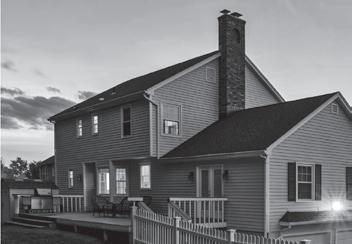
In addition to your creative talents, you’ll be a skilled copywriter, communicator, and digital manager. Your ability to craft compelling messages and manage various online platforms will be key to our success. We’re looking for someone who takes pride in their work and is committed to the team’s collective growth and success. Working closely with our Executive Director, you’ll have the opportunity to collaborate on exciting projects and coordinate with other specialists or consultants. The Winthrop Chamber of Commerce is driven by passionate business owners dedicated to promoting Winthrop and building a vibrant community.
If you’re ready to make a difference and thrive in a dynamic team environment, apply now and join us as we embark on this exciting marketing journey. Together, we’ll create impactful campaigns and contribute to the success of our organization and the businesses we support. This part time role requires a flexible 20 hours per week of work in Winthrop. Pay is $30 per hour.
Candidates must reside in the Methow Valley. Please email a resume and cover letter with brief outline of your experience as a part of a marketing team to; chamber@winthropwashington.com
HOME BUYERS
Are looking for your real estate ad in the Methow Valley News. Call (509) 997-7011 to place your ad









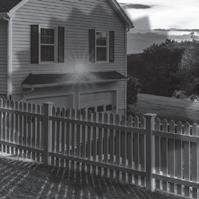




































the date, time and place indicated.






































Pursuant to
197-11-350(3), the
has been clarifi ed, changed, and conditioned to include necessary mitigation measures to avoid, minimize or compensate for probable signifi cant impacts. An environmental impact statement (EIS) is not required under RCW 43.21C.030. The necessary mitigation measures are listed below, the Environmental Checklist is attached, and the application, special studies and related materials are available at: townoftwisp.com This determination is based on the following findings and conclusions:
The application for the proposed planned development underwent a preliminary review process wherein a Determination of Non-Significance (“DNS”) was issued by the Town and was subject to numerous comments and several appeals. As a result, the Town withdrew the DNS and provided the applicant with a list of items to address in a revised SEPA Checklist and application for the planned development (“PD”). The Town issued a Mitigated Determination of Non-Significance (“MDNS”) on January 5, 2023, which was withdrawn as it was on the wrong form, then a new MDNS was issued on February 1, 2023, which was also withdrawn on March 23, 2023, when a commentor correctly pointed out that the notice provided did not meet the requirements of state statute. The Planning Commission completed the required Public Hearing process on April 26, 2023, then began discussion of the conditions to be placed on the recommendation for preliminary approval of the PD. The hearing process entailed the Planning Commission completing its discussion of the proposed conditions on
administrative appeals for this MDNS because the decision on the underlying permit is being made by the Town Council. TMC 16.05.200(5). Therefore, in accordance with RCW 43.21C.075(6)(c) and TMC 14.05.070(6), any appeals of this MDNS may be taken to Okanogan County Superior Court in conjunction with the underlying decision by the Town Council. Such appeal must be filed no later than 21 days following issuance of the Town Council’s decision on the PD in accordance with the deadlines contained in Chapter 36.70C RCW. Orchard Hills Planned Development Mitigation Plan
One of the conditions for preliminary approval of the PD requires that all mitigation measures set forth in the revised SEPA Checklist and any addendums thereto are required to be implemented and maintained throughout the life of the project.
1.Air Quality. The applicant notes in the SEPA Checklist that all woodstoves must meet current state and federal standards and that the Department of Ecology publication “Methods for Dust Control” 2016 will be utilized to prepare a dust control plan in accordance with the Town of Twisp’s codes and regulations and best management practices. Mitigation conditions for preliminary approval of the PD should require that the final approval contain either Plat Conditions and Restrictions limiting each dwelling unit to one wood burning apparatus with no wood-burning fireplaces allowed or, in the alternative, that the applicant record Covenants, Conditions and Restrictions on all the lots containing this restriction. The issue of re-suspended dust from winter sanding operations is a Town issue that is not the responsibility of the developer.
2. Glare and light pollution. The applicant notes in the SEPA Checklist that the project will adhere to current Town lighting standards and will limit all building sites to at least 30’ below the ridgeline. Demonstrated compliance with Town lighting standards in effect at the time of building permit application(s) (including standards provided in TMC 18.15.070) will be adequate to mitigate light and glare. The conditions for preliminary approval of the PD should require that no building site be developed that is not at least 30’ below the nearest ridgeline. The applicant will demonstrate compliance with this condition prior to issuance of approval of the Final PD.
3. Critical Areas and Wetlands. Portions of the project site have been designated as Geological Hazardous Areas and Critical Aquifer Recharge Areas in the Town’s Comprehensive Plan. The applicant submitted the following reports prepared by qualified professionals: Geotechnical Report, a Limited Environmental Investigation, Wetlands Determination and Delineation, Habitat Assessment, and Lead and Arsenic Testing report. The studies provided data on the soils, topography, soil permeability and potential contamination from historic use

of portions of the site as a commercial orchard. In general, the Geotechnical Report found the site suitable for the type of development being proposed and contained recommendations for measures to reduce potential impacts. The mitigation measures contained in the reports prepared by qualified professionals and submitted by the applicant should be made conditions of approval of the Final PD. The Limited Environmental Investigation did find evidence arsenic in the soils on the project site and made the following recommendation:
Because arsenic was detected in soil above the MTCA Method A cleanup level at the Subject Property, Ecology requires additional environmental investigation and/or cleanup to meet the requirements of MTCA and Ecology’s Model Remedies for Cleanup of Former Orchard Properties in Central and Eastern Washington (July 2021, Publication No. 21-09-006). The highest concentrations of arsenic were measured in soil samples collected at depths of 8 and 10 feet bgs from test pits located nearest the bedrock ridge in the western portion of the Subject Property. It is possible that naturally occurring arsenic in the bedrock is a source of arsenic to soil at the Subject Property. However, because the Subject Property was historically used as orchard land, Ecology will likely require a background study of naturally occurring arsenic, completed in accordance with WAC 173-340-709, to establish area soil background concentrations and evaluate future cleanup requirements for the Subject Property.
The applicant notes in the SEPA checklist that temporary sediment/ erosion control measures will be incorporated during construction to prevent sediment transport off site. NPDES Construction Storm Water Permit from DOE will be obtained, and an associated plan implemented. All land disturbed during construction will be stabilized and revegetated. Measures to reduce or control erosion include stormwater management and dedication of permanent open space. The applicant provided a Wetlands Assessment conducted by a qualifi ed professional. The Assessment found no wetlands on the subject property.
4.Design Standards.
As the applicant notes in the SEPA Checklist, the project will be required to comply with the Town design standards for public and private infrastructure and for the individual dwelling units. The applicant will adhere to such standards as are in effect at the time of the submittal of building or development permits. In addition, the applicant will be subject to the development standards contained in Chapter 18.45 TMC.
5.Density.
The proposed PD includes 52 individual single-family residential lots ranging in size from 3,630 sq ft to 8,903 sq. ft. with 3 open space tracts of 8,390 sq. ft., 116,669 sq. ft. and 171,156 sq. ft. The PD was determined to meet the density standards set forth in the Twisp Zoning Code (Title 18, Table 5).
While the proposed development is in an area zoned R1, with a minimum lot size of 10,000 sq ft, Table 5 contains a footnote indicating that the minimum lot size does not apply to a PD. Comprehensive Plan and Zoning regulations encourage PDs as a means to protect open space and critical areas by allowing flexibility in design, which includes clustering of dwellings on smaller lots. Preservation of the open space in perpetuity will off-set the clustered density proposed in the application.
6. Traffic. The applicant notes in the SEPA Checklist that a study by independent consultant SJC Alliance estimates that there will be 563 new trips per day on May St and Harrison Ave. The study noted that the existing street network has the capacity to handle the increased traffic, The applicant also provided a supplemental traffic study that examined the current and projected capacity of the intersections of May Street and Second Avenue and Second Avenue and S.R. 20. The
consistent with the Town’s Emergency Response Plan, as it may be amended from time to time. 7. Stormwater. The applicant states in the SEPA Checklist and a preliminary Stormwater Management Plan that stormwater runoff will result from developed hardscape areas including buildings, roadways, pedestrian paths, and parking areas. These areas will be directed via sloped surfaces and conveyance piping to water quality and infiltration swales or dry wells designed and sized to meet the requirements of the DOE Stormwater Manual for Eastern Washington 2019.
A stormwater management plan compliant with Town standards and the Eastern Washington Stormwater Management Manual must be prepared by a licensed engineer and approved by the Town prior to final approval of the PD. The stormwater plan will ensure that stormwater runoff from the development is retained, treated, and dispersed within the project boundaries. In addition, the stormwater plan improvements must be constructed or bonded prior to final approval of the PD. The stormwater system may not be located in the preserved open space.
8. Consistency with Comprehensive Plan.
The applicant states in the SEPA Checklist that the proposal is developed pursuant to adopted Town of Twisp regulations. This is a proposed residential development with less overall density than the current zoning. The PD will be consistent with the Town’s comprehensive plan.
9. Consistency with Zoning Code.
The applicant states in the SEPA Checklist that the proposal is developed pursuant to adopted Town of Twisp regulations. This is a proposed residential development with less overall density than the current zoning.
The Staff Report prepared for the Planning Commission noted that there are conflicts between the Comprehensive Planning and Zoning code: “There is a conflict between the intent of the R1 zoning district and the regulations which provides for the reduction of minimum lot sizes through the PD process. There is also a conflict with the comprehensive plan which calls for a maximum density of 4 units per acre rather than the 6 permitted under zoning. However, as the zoning code has been adopted by ordinance, the zoning provisions prevail. The proposed use is considered allowed as it consists of single-family residences and falls within the allowable zoning density providing it follows the requirements for a planned development.” The PD may be conditioned to create consistency with the Town’s zoning code.
10. Wildfire Risk.
One of the key issues raised during the public review process was wildfire risk and the impact the number of new dwellings would have on traffi c in the event of an emergency and the small lots limiting the space between structures thus contributing to fire spread in the event of a wildfire. The Town retained a professional Fire Marshal who visited the site, reviewed the plans, and provided recommendations that addressed both issues. The applicant also provided a professional report on wildfire risk and mitigation measures that were reviewed by the City’s retained professional Fire Marshal. In order to mitigate the risk of harm to people, animals, property, and the environment, the following mitigation measures should be implemented prior to final approval of
ed and must be maintained yearround by the applicant or successor HOA, unless made public.
• Public and private roads that do not have wide radius turn arounds have been shown to create issues with snow clearing and storage which can impede emergency access. Any public or private deadend streets and lanes shall meet all applicable codes. Private roads and access ways shall include design for snow clearing and storage in order to not impede emergency access and which does not result in snow being pushed onto the public street.
• In the event of an emergency, evacuation of the PD and adjoining neighborhood will occur consistent with the Town’s Emergency Response Plan, as it may be amended from time to time.
• That all construction will be completed in compliance with applicable requirements of the International Building Code and all homes meet the 2018 International Wildland-Urban interface code, including being constructed using Class 2 Ignition-Resistant construction methods and materials. This requirement shall be recorded either as a note on the final plat, or this requirement shall be recorded as part of Covenants, Conditions, and Restrictions for the development prior to approval of the Final PD.
• In addition, all home(s) shall be equipped with NFPA 13D fire sprinkler systems. This requirement shall be recorded either as a note on the final plat, or this requirement shall be recorded as part of Covenants, Conditions, and Restrictions for the development prior to approval of the Final PD.
• That each lot shall be labeled with an E911 address prior to filing and recording of PD Plat.
• That the applicant have a fire hazard reduction plan prepared by a qualifi ed professional, which is subject to approval by the Town. The applicant must implement said approved plan in the proposed open space area south of Harrison Street prior to fi nal approval of the PD.
11. Contamination from previous agricultural use.
Portions of the project site have been designated as Geological Hazardous Areas and Critical Aquifer Recharge Areas in the Town’s Comprehensive Plan. The applicant submitted a Geotechnical Report and a Limited Environmental Investigation prepared by qualified professionals. The studies provided data on the soils, topography, soil permeability and potential contamination from historic use of portions of the site as a commercial orchard. In general, the Geotechnical Report found the site suitable for the type of development being proposed and contained recommendations for measures to reduce potential impacts. The Limited Environmental Investigation did find evidence arsenic in the soils on the project site and made the following recommendation: Because arsenic was detected in soil above the MTCA Method A cleanup level at the Subject Property, Ecology requires additional environmental investigation and/or cleanup to meet the requirements of MTCA and Ecology’s Model Remedies for Cleanup of Former Orchard Properties in Central and Eastern Washington (July 2021, Publication No. 21-09-006).
The Winthrop Town Council has decided not to consider amending the town’s zoning code to allow residential uses in the B3 business zone.
At its meeting last week, the council instead opted to wait for Planning Commission recommendations on possible zoning code amendments rather than act on a single request.
At an earlier meeting, chiropractor Dr. Lawrence Delisi asked the council to amend the town’s zoning code to allow the building on Highway 20 that he has been using as his office for 33 years to revert to residential use. Delisi said he is retiring and the building is for sale.
Delisi’s office is in the town’s B3 business zone. The building, formerly used as a home, became designated a commercial space after Delisi purchased it in 1990. Town Planner Rocklynn Culp said residential use would not be allowed unless the council decides to revise the existing code to allow an exception.
In a memo to the council prepared for last week’s meeting, Culp noted that some types of residences are allowed in B3 but only if the primary use of the building is commercial. There are some houses on Highway 20 that were grandfathered in years ago because they were continuously used as residences, Culp said. Delisi’s building was not one of those. Culp said the council code maintain the code as is to preserve land for commercial uses. Such properties are limited in the town, she said.
Alternately, the council could consider amending the zoning code as part of an effort to increase housing availability in the town, Culp said. Or, it could wait for the Planning Commission’s review.
Council member Bill McAdow said he preferred the “do
nothing” option at this point because he believes the area is properly zoned and no immediate changes are needed. Other council members agreed.
In other business:
• The council learned that the town has received a $258,000 grant from the state Department of Commerce for installation of solar panels on the roof of the Winthrop library. Plans for the library, which opened in 2022, have always included a solar option. More information wasn’t immediately available.
• In answer to a question about why the Rivian electric vehicle charging stations in the library parking lot are not working, Town Clerk Michelle Gaines explained that the stations were mistakenly connected to the library’s electrical system. The electric service to the stations, which are privately operated by Rivian, needs to be altered so the two connections are separate, she said.
• Christian Kar, representing Live Work Play LLC, suggested that the town consider a adopting a “multi-family housing tax exemption,” provided for through the state Department of Commerce, that would allow property tax waivers for certain residential improvements for between eight an 20 years. The property owner would still pay taxes on the land. The state program is intended to encourage affordable housing development.
At an earlier meeting, Kar asked the council to consider allowing on-site sewage treatment for a proposed 28-unit, dormitory-style affordable housing development on property directly above the town ballfield on West Chewuch Road. That proposal is under review.
Live Work Play also owns the nearby Mountain Annex building, which is outside the town limits, and is proposing to develop 60 similar housing units on a 2-acre site there.
• The council heard from longtime downtown property
owner John Lester about what he said was a lack of enforcement of Westernization code requirements on Riverside Avenue. Lester, who has made the same observation in the past, has some knowledge of the topic: He was one of the original property owners involved in westernizing the town in 1972, and has been supportive ever since.
Lester said the Westernization code is too often ignored and “sloppily enforced,” and “it’s time to buckle down.” He noted that property owners have some responsibility for upkeep, and know going in that “a theme town ain’t cheap.” He said the boardwalk needs repair in several places.
Council members agreed it would be reasonable to, as council member Ben Nelson put it, “start with the low-hanging fruit” by notifying property owners of problems that could be addressed sooner rather than later.
John Lester’s wife, Carol, also addressed the council about the recently hot topic of employee parking in the downtown area. She pointed to a provision in the town code that allows business owners to “mitigate” parking requirements for employees by paying into a town fund that is earmarked for parking improvements — but has rarely been utilized.
Carol Lester urged the council to put the parking fund to better use, because the code provides that the mitigation frees must be returned to business owners if they are not used within five years.
Later in the meeting, McAdow said the town should not be the only entity that is expected to address the parking problem, and suggested that private owners with available land could consider creating paid parking lots. As an example, he cited the property where until recently the Winthrop Marshal’s Office was housed. “There are places to park if people put a little more effort into it,” he said.
GET READY FOR DUCK DAYS
Winthrop Kiwanis Duck Days, two days of family-friendly activities capped by annual Labor Day Duck Race, are set for Labor Day weekend, Sept. 3-4.
Duck Days will again offer a variety of attractions in Mack Lloyd Park on Sunday, Sept. 3, from noon-4 p.m., including food, music, games, crafts, a dunk tank and duck bingo.
The Duck Race is on for Labor Day, Monday, Sept. 4. The race typically begins at noon when a couple of thousand plastic ducks are dumped from the Chewuch River bridge in Winthrop for a journey through the confluence before reaching the finish line at the Methow River bridge.
Tickets are now on sale for entrants in the Duck Race, online at winthropkiwanis.com or look for the giant inflated duck at places around the valley to buy your tickets from a Kiwanis member. Tickets are $5. Corporate entries will be available as well.
If your duck wins, your ticket pays off with a cash prize. Prizes are also awarded for second through fifth places. First prize is $500; 2nd prize, $300; 3rd prize; $100; 4th and 5th prizes, $50.
TwispWorks is opening up its campus on the fourth Friday of each month for music and studio visits. The events are free and open to all.
Our Western/First Winter Sale is coming up on Saturday, Sept. 2, from 9 a.m.-noon. It will be held outside. Our devoted volunteers have been working hard and I’m sure there will be lots of treasures for everyone. As a reminder, our senior lunches are Monday, Thursday and Friday. Give Greta a call at (509) 997-7722.
Colleen Ramiskey
• Friday, Aug. 25, music by Friday Feels from 7:30-10 p.m.; partner studios open from 5-7 p.m.
• Friday, Sept. 22, music by Essential I and WritRwhoRaps from 5:30-6:30 p.m., and The Panda Conspiracy from 7:30-10 p.m.; partner studios open from 5-7 p.m.
Twisp Library Friends is sponsoring a Labor Day weekend Twisp Library Book Sale in the Methow Valley Community Center gym on Friday, Sept. 1, from 4-7 p.m., and Saturday, Sept. 2, from 8:30 a.m.12:30 p.m. For information, call (509) 449-2594.
The Methow Conservancy’s next “First Tuesday” presentation, on Sept. 5, is “Lynx and Wildfire in the Methow Valley.” The free event starts at 7 p.m. at the Winthrop Barn. Carmen Vanbianchi, research director and co-founder of Home Range Wildlife, will give an overview of the organization’s research so far including stories from the field, images of the three adults that were live-trapped during the winter field season, and a demonstration of how live traps work to safely capture and release these charismatic cats. For information, visit https:// methowconservancy.org/news/category/events.
LUNCH MENUS THURSDAY, AUG. 24: Sweet and sour pork, steamed rice, Oriental vegetables, cucumber salad, tropical fruit, egg roll, desert.
FRIDAY, AUG. 25: Taco salad, Spanish rice, mixed fruit, tortilla chips, dessert.
MONDAY, AUG. 28: Biscuits and gravy, hash brown potatoes, V-8 juice, fresh fruit, mu n.
THURSDAY, AUG. 31: Cheeseburger deluxe, three-bean salad, coleslaw, peaches, dessert. Call (509) 997-7722 to reserve meals 24 hours in advance. Suggested donation is $5 for persons over age 60; charge for $10 for persons under 60.
Twisp, where he enjoyed spending time working on vehicles, hiking, and exploring with friends.







daughter and two sons were born to Wayne and his wife, Sandra Tucker. He later married Debbie Moore and had another daughter. He started his career in mechanics working on vehicles, but over time he developed an expertise in farm machinery. He fulfilled a lifetime dream of running his own small business when




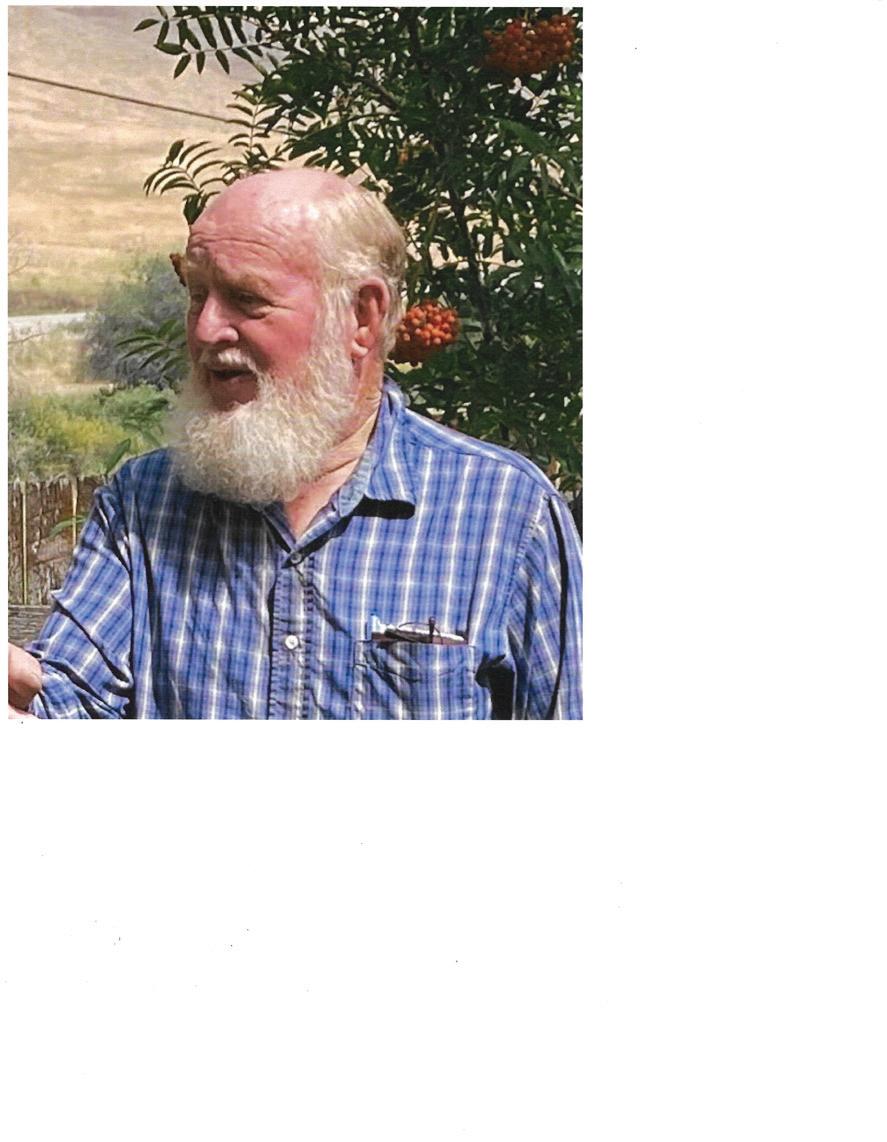
he moved to Oregon and started McCorkle Repair. It gave him pleasure to find ways to help people. He loaned vehicles, offered rides, and supported the farm community in the greater Portland area. He loved the Lord and had a heart for worship. He is survived by his children: Laurel (Paul) McCorkle Diaz, Eric McCorkle, Daniel McCorkle and Julie McCorkle; and by his grandchildren, Isabella and Christopher Diaz. Surviving siblings: Clarence McCorkle, Fred (Deb) McCorkle, Helen (Bob) Reed, Doris (Bill) Tonseth, Sharon (Ken) Davidson and Philip (Julie) McCorkle. A celebration of life with potluck will be on Aug. 26 at 4 p.m. at Cascade Bible Church in Twisp.





Heidi Ann Breitbeil, 55, Winthrop, and Michael Alan Strauss, 60, Winthrop
Catherine Susan Tysver, 33, Pateros, and Blayne Timothy Harvey, 30, Pateros

























WE






































It must be like Christmas when PCT hikers receive their pre-packed boxes at designated mail drops along the 2,650-mile trail. Such was the excitement when six hikers gathered around a picnic table in the Mazama Store courtyard on Saturday (Aug. 19). Hailing from New York, Oregon, California, Washington and Minnesota, the group, most who met each other on the trek, picked through their goods. Only one problem — fire!
Fires have affected so many in a multitude of places. Of course, Lahaina and now Medical Lake here in Washington, come to mind for the loss of

Artist Ralph Bennett is a fifth-generation woodcarver of the Haida Tribe, whose traditional territory includes parts of southern Alaska and the archipelago of Haida Gwaii (also known as the Queen Charlotte and Prince of Wales islands in British Columbia). Bennett, whose Haida name is Goo la’Slacoon (Abalone Fingers), has been creating and teaching art for four decades, to national and international acclaim. He won a Governor’s Heritage award in 2000.
One of the students lucky enough to have worked with Bennett was Robert Moore, the uncle of Winthrop resident Liz Brackett. Twenty-five years ago, Moore carved a 6-foot-tall Raven totem pole inspired by the Haida tradition, which has been installed at the Studhorse home of Brackett and her late husband, Pete.
When Pete passed away in May 2023, Liz began considering gifting the totem pole to the Town of Winthrop, to be displayed as public art for residents and visitors to enjoy. Pete was a surveyor and helped survey the site of the new Winthrop Library, so he had a connection to the Town of Winthrop. The new library apparently isn’t a good fit for the artwork, but after a presentation by Methow Reservations co-owner Kyrie Jardin and Friends of the Winthrop Library board chair Craig Seasholes, the Winthrop town council is potentially open to the idea of installing the totem pole in a different location.
“It’s not Methow-made art,” Jardin says, “but it was made with good inten-

life and home. Fires rage across British Columbia, our neighbor to the north, with an order issued by the province banning non-essential travel to fire-affected communities in their Okanogan country. With 35,000 people displaced, looky-loos are not needed.
Smoke has descended across the state, closing highways — even Interstate 90 — and disrupting plans. With the North Cascades Highway closed, quiet envelops our valley as reservations are canceled and restaurants and stores experience a loss of revenue without the usual summer tourist traffic. Hopefully, residents will step up to the plate and patronize the businesses — shop and eat local. Your neighbors will appreciate the support.
Seeing the sun burning red through the smoke is an indicator that the air quality is not healthy. Purple Air website provides area specific air quality readings. The Mazama Trailhead sensor recorded air pollutants at 365 on Sunday (Aug. 20) — 301 and higher are considered hazardous. Our little air purifier that was given out by a generous corporate donor during the Cedar Creek/ Cub Creek fire year frowns red (I call her Cruella), as it struggles to clean the inside air.
Back to the PCT hikers and fire.
Their packages came with the intent that there would be one more week of hiking before finishing their arduous endeavor. Because of the Sourdough Fire, portions of the trail were closed, leaving the hikers with only three days left to complete their journey. Why pack a week’s worth of food when you only need three days, they were wondering. “Would you like some snacks?” they offered me.
Mazamans showed up for Methow
Fresh’s launch party at their new Rolling Huts location on Friday (Aug. 18). The space will serve them well to continue to offer their current specials as well as pizza and salads.
For the occasion, Jeff Palmberg, who identifies as the Grand Poobah and Doodle Master at JP’s Custom Caricature (aka pastor at Community Covenant Church in Twisp), offered to sketch caricatures of the patrons, a side gig he has been doing for 40 years. It’s a trip to see what you might look like if you were a cartoon character! Thanks, Jeff.
Finally, before the air quality numbers shot up, a horse ride on Founder’s Trail to the Tawlks-Foster Suspension Bridge encountered a few walkers and bicyclists. It was encouraging to see that the Lower Goat Creek Bridge work is in progress by Methow Trails.
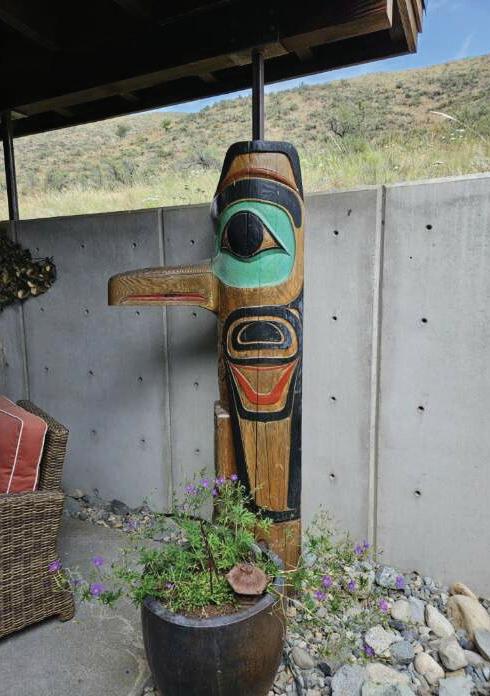
tion. If there’s an appropriate place in town to install it, it would be an interesting piece of public art.”
Jardin, who got acquainted with the Bracketts when Pete began cancer treatments in Seattle last winter, is now in possession of the totem pole, which he hauled to the town council presentation in a trailer.
The Methow Valley is home to a tremendous number of public art pieces relative to its population including: William Stafford’s Methow River Poems; steel spheres created by the late Bernard Hosey; glass tile mosaics; acrylic murals; cast aluminum pieces by Steve Love and the late Richard Beyer; metal
It’s difficult to gaze out the window and think of anything else but the elephant in the room. Or the elephant in the air.
Speaking of elephants, the Twisp Feed reader board had a joke about an elephant this week. “Why can’t you see the elephants hiding in the trees?
Because they’re so good at it.” At first, it was so literal, I didn’t get it. I figured I was missing something more subtle, or witty. Katrina helped me see the forest for the trees and then I realized I was missing something — my sense of humor. I think I’ve found it again, and that’s good because we all need some humor to get through the next few weeks of the smokapolypse.
panels
Twisp Creative District; Barry Stromberger’s giant Beeest wasp
a more comprehensive —
If a suitable place for Moore’s Raven can be agreed upon, the Methow Valley’s public art collection may soon be one piece richer.


From my front yard I watched the pyrocumulus clouds rise from the fires in Canada. From her post at Goat Peak Lookout, Christine Estrada photographed astounding images of the fire glow — these can be seen on her Facebook page, “Where in the Wild is Chris?” I thought about the traditional Sinixt and Okanogan territories burning north of the border, and the instrumental role Methow Valley’s Richard Hart had in a landmark court ruling regarding those ancestral lands. His archival papers related to the case were recently made available online by the Inchelium Cultural Research Center.
The Sinixt traditional territory borders the Okanogan territory to the east, and stretches from Nelson to Revelstoke, B.C. The anglicized name of the Sinixt is “Arrow Lakes,” or, “Lakes.” In 1872, the Sinixt people were forcibly removed from their lands in Canada to the Colville Reservation in Okanogan County, along with 11 other tribes. In 1892, the northern half of the reservation was eliminated, completely cutting off the Sinixt from their homeland. In 1897, British Columbia made it illegal for the Sinixt to cross the border to practice aboriginal rights, and in 1956, the Canadian government declared the Sinixt extinct — despite the nearly 3,000 members existing on the Colville Indian Reservation.
In 1989, construction began on a highway, bulldozing through a known burial site, and unearthing human remains. Residents in British Columbia notified the Sinixt. Richard Desautel and his wife Linda, along with other Sinixt descendants, traveled to Nelson, B.C., to request
the return of their families’ bones for proper burial. The request was ignored. The surviving Sinixt realized that in order to protect their ancestors, they needed to abolish the “extinction” declaration.
For 20 years, the Sinixt tried every course to reverse the ruling and gain legal access to protect archeological sites and graves, and conduct ceremonial hunting. Every request was denied. In 2010, after consulting with legal counsel, historians and tribal leaders, Rick Desautel was chosen to harvest an elk within Sinixt traditional territory — a test for the judicial system.
Rick, a retired Fish &Wildlife Officer, is a Sinixt Tribal Member and Ceremonial Hunter. After harvesting the elk, Rick turned himself in to the B.C. conservation officer and was cited for hunting as a non-resident without a proper license. In 2017, a lower court agreed that Sinixt had rights in their aboriginal lands and acquitted Rick. The government appeal was considered of national importance and was presented to the Canadian Supreme Court, titled, “Richard Lee Desautel vs. Her Majesty the Queen” in October, 2020.
Attorneys for British Columbia claimed by moving south of the 49th parallel, the Sinixt gave up their rights in Canada, and stated the Sinixt, “left enthusiastically to embrace farming.” This statement was emphatically disproven beyond a shadow of a doubt by Sinixt Elders and their expert witness, ethnologist Richard Hart. On April 23, 2021, Canada’s highest court ruled in favor of Sinixt and their aboriginal rights in the Lakes territory.
Richard’s role was instrumental in the case. In particular, his article, “Maps Showing Sinixt Territory, 1811-1846” in the Canadian Cartographic Association peer-reviewed academic journal Cartographica was a strong argument for the Sinixt claim to traditional territories.
Richard’s digital archives are free to access and are located online at www. incheliumcrc.org/richard-hart-collection. Derrick LaMere, a Sinixt descendant and award-winning documentary film director, documented the court case with his production, “Older than the Crown” — a collection of archival footage and personal interviews. His film can be viewed for free on PBS at www.pbs.org/ show/older-crown.
To view an interactive map of traditional territories in our region, visit “A Brief History” at www.colvilletribes.com.
At the risking of lumping the current grasshopper plague into a Biblical scale prophesy foretelling the end of the world or as a warning to head the power of God, the struggle on the ground is real. For the first time ever, I planted dahlias, only to open their glorious blooms and get annihilated. Their petals serrated and mowed down into stubby little blobs of color, offering a fraction of the joy intended. Across the garden, everything is munched.
Local tales of grasshopper wars include epic waves of jumping arthropods rippling through fields and lawns.
Amongst the fires and floods ravaging communities across the continent and nearby, here at home we are battling a silent war this summer that has affected everyone. Less serious than the destruction our fellow countrymen have endured, no one here at home seems spared in the fight against the grasshoppers.
The word from Bear Creek golfers is
that the grasshoppers are creating a fantastic sea of wavelike swarms across the fairways as the carts cruise towards the greens. Then the greens themselves are reported to be blanketed with little hoppers, making curious obstacle course for putters.
It’s well known that traditional diets in cultures, the world over, eat grasshoppers, or similar, for high protein nutrition. Climate-conscious food companies are now integrating grasshoppers into pet food and even a few startup companies have started farming them for human protein powders.
Our family tried fried and salted grasshoppers on an oversea trip a couple years ago. They are a common street snack food in parts of the world, and feeling adventurous, we indulged. I wish
I could say it tasted like chicken. No, it tasted like grasshoppers. Crunchy, bitter, and mushy in the middle. Then, flakes of the exo-skeleton got stuck between our teeth, requiring rinsing and flossing, all together imprinting the entire culinary trip as an unsavory experience.
There’s a cycle to these grasshopper outbreaks. Scientists say it’s the conditions in the fall that create the spring hatch. Perhaps the warm long October last year contributed to this year’s abundance. Perhaps it’s a warning, a sign of a changing climate. Perhaps it’s divine intervention. But I am optimistic that it’s not a sign of the end of the world, and if it were, we probably wouldn’t see it. After all, there could be an elephant hiding in the woods, and we wouldn’t know it.